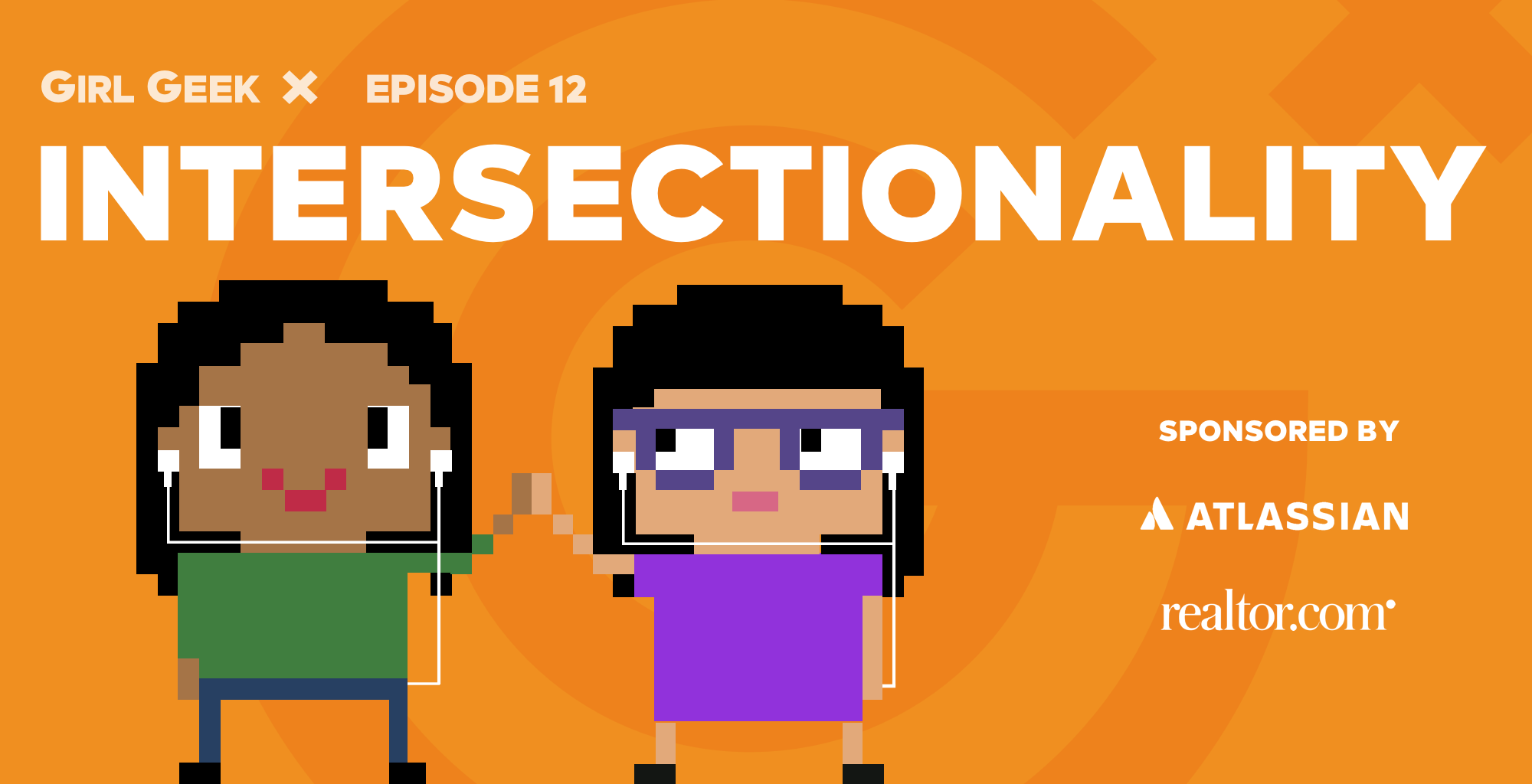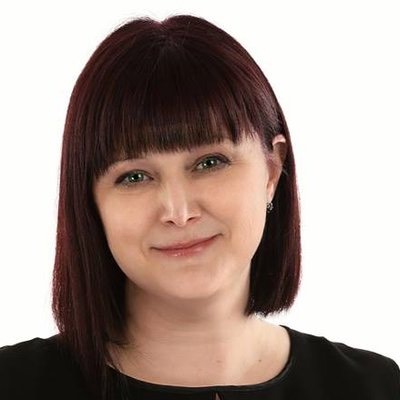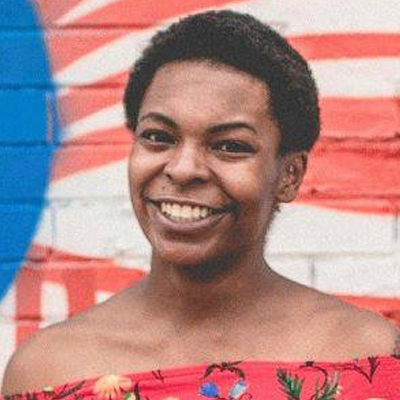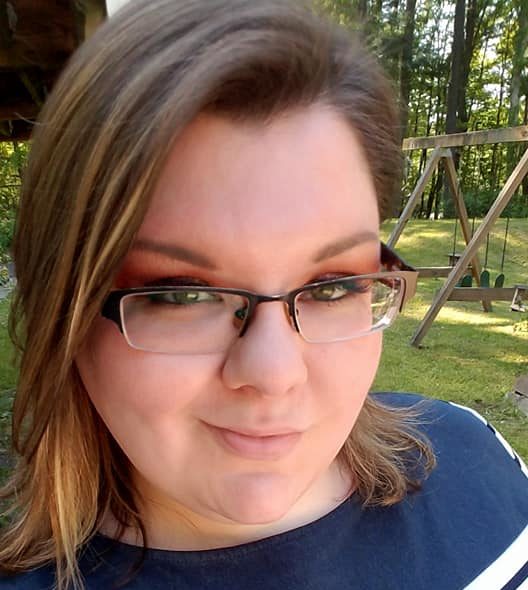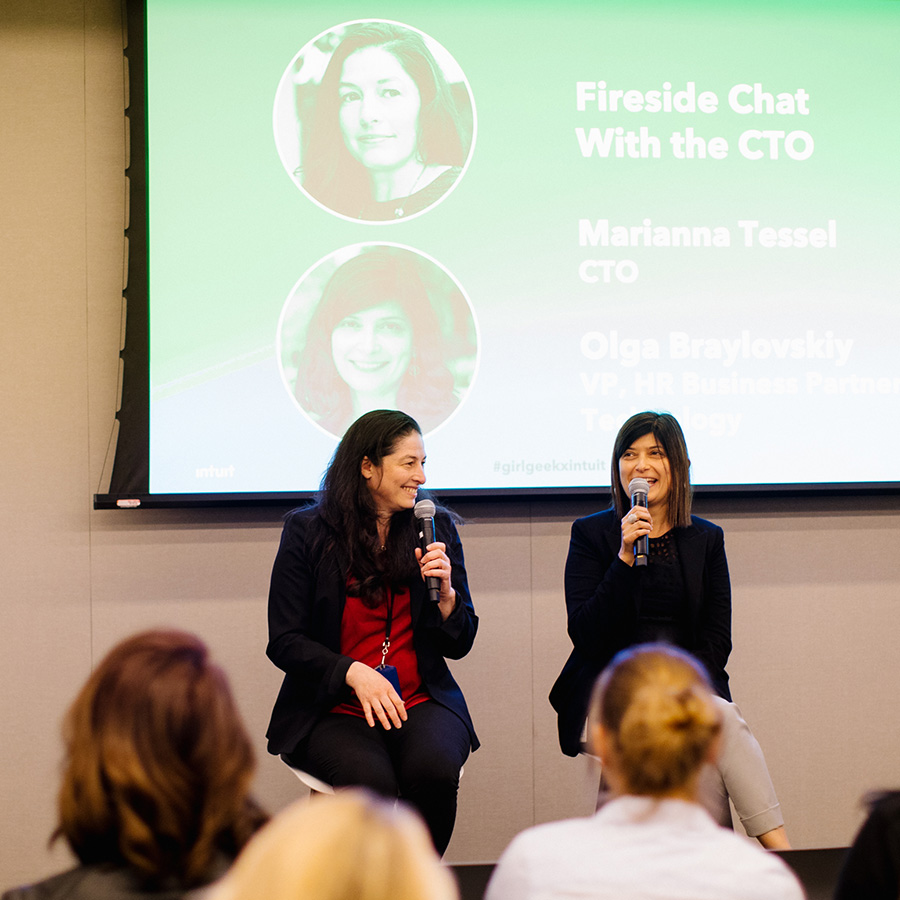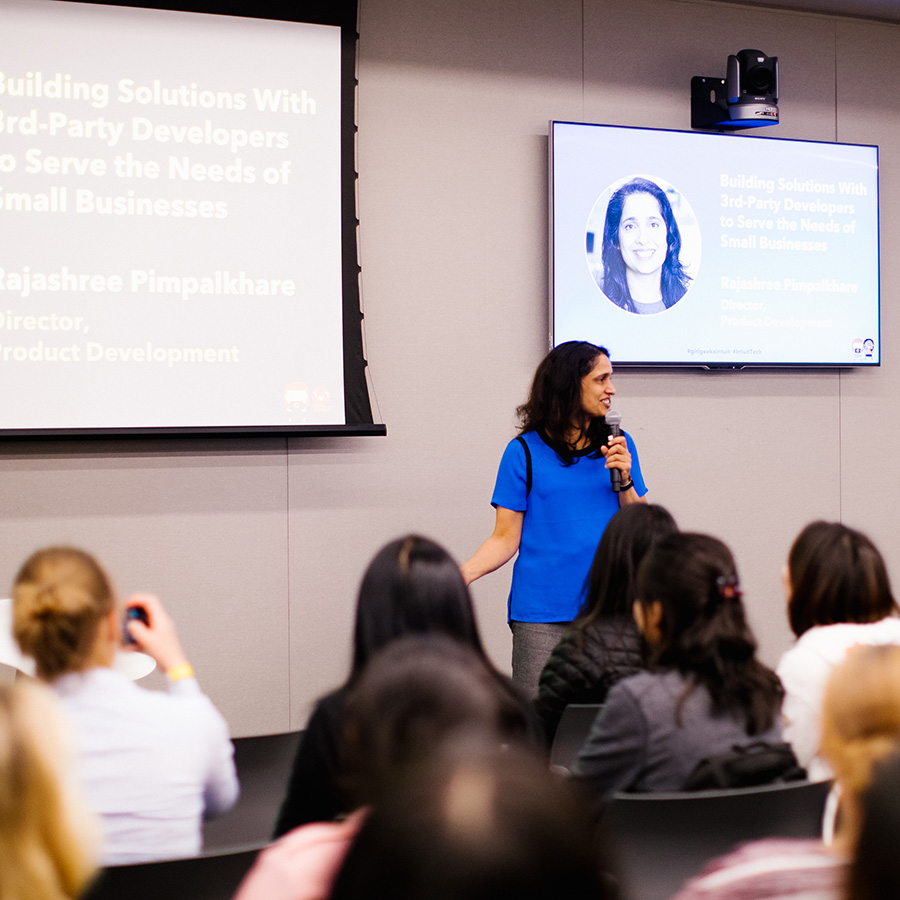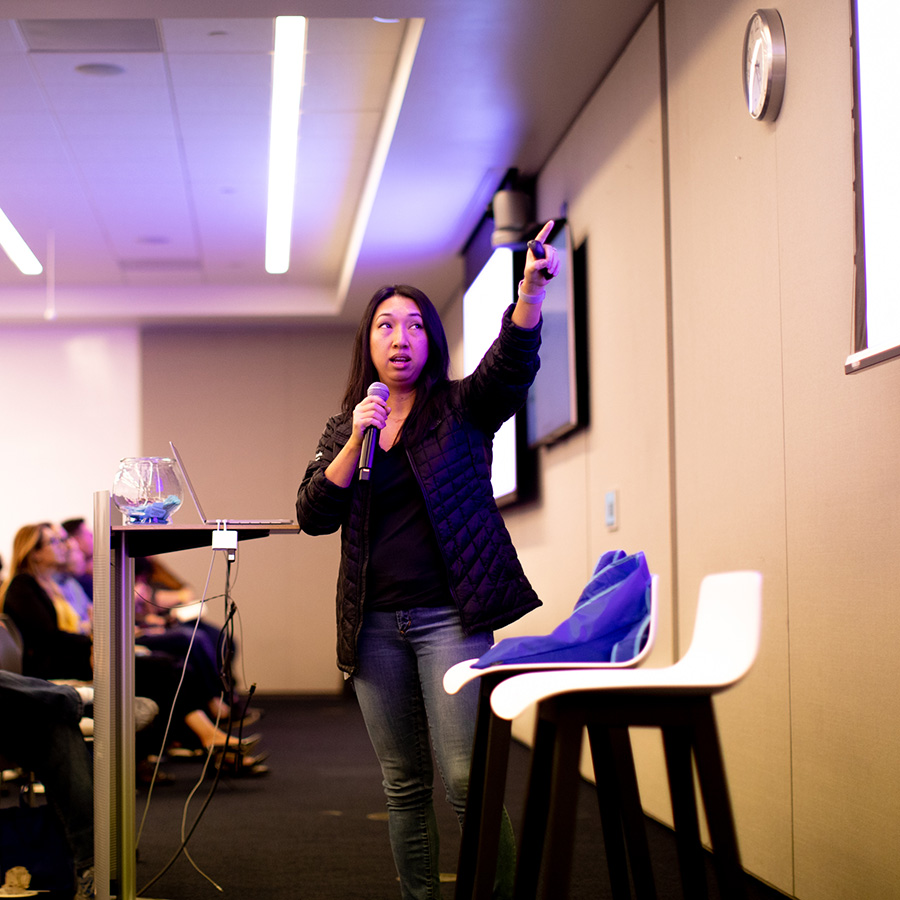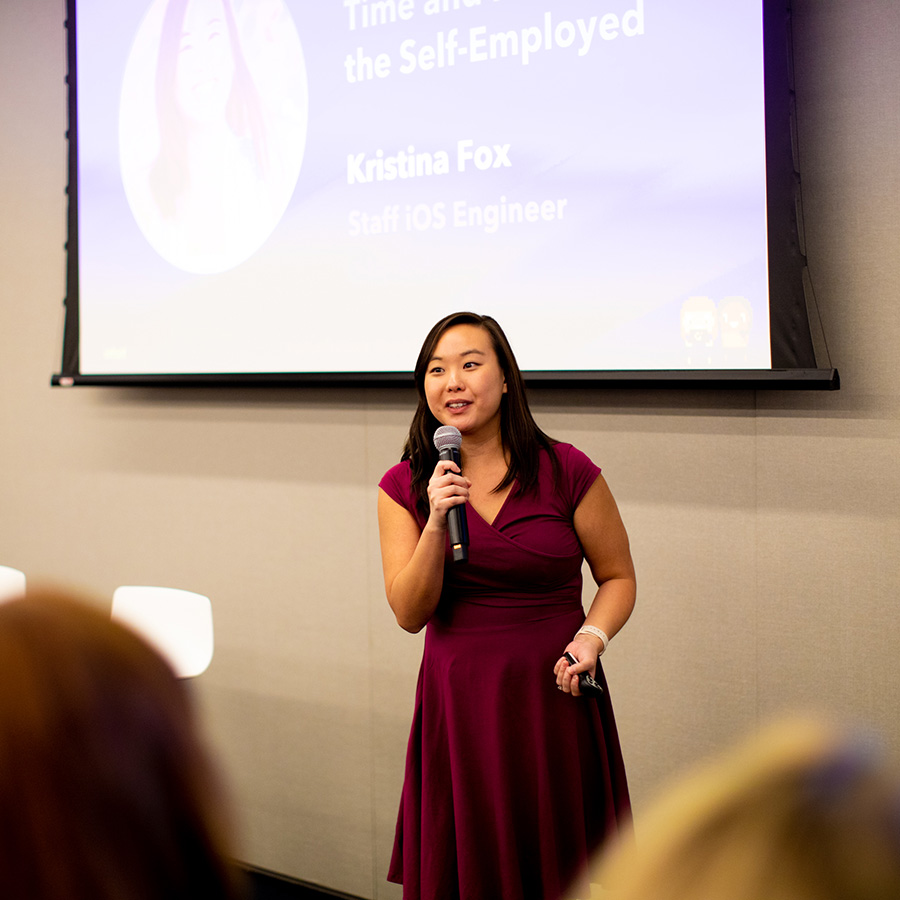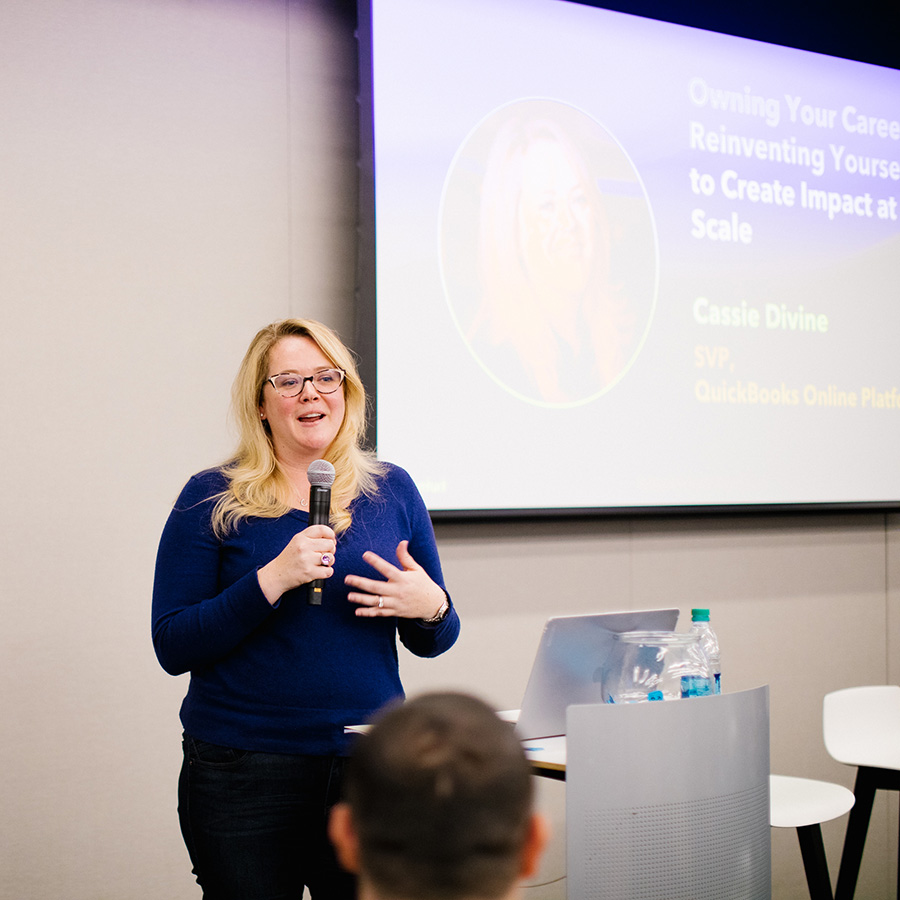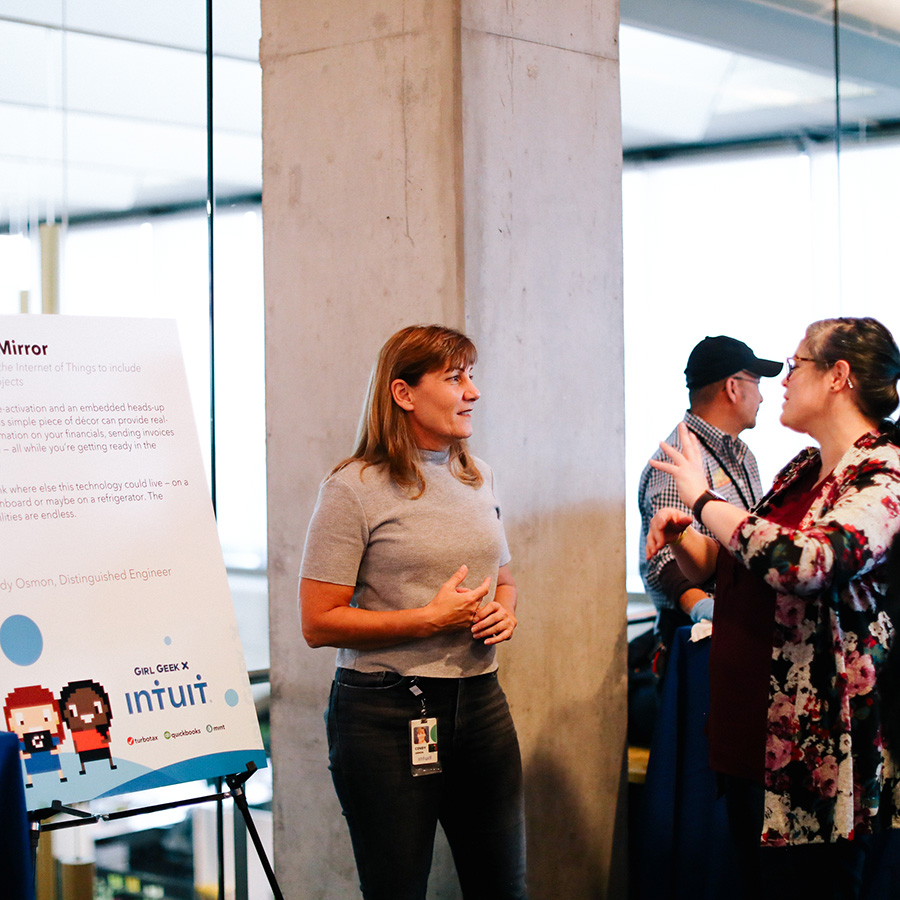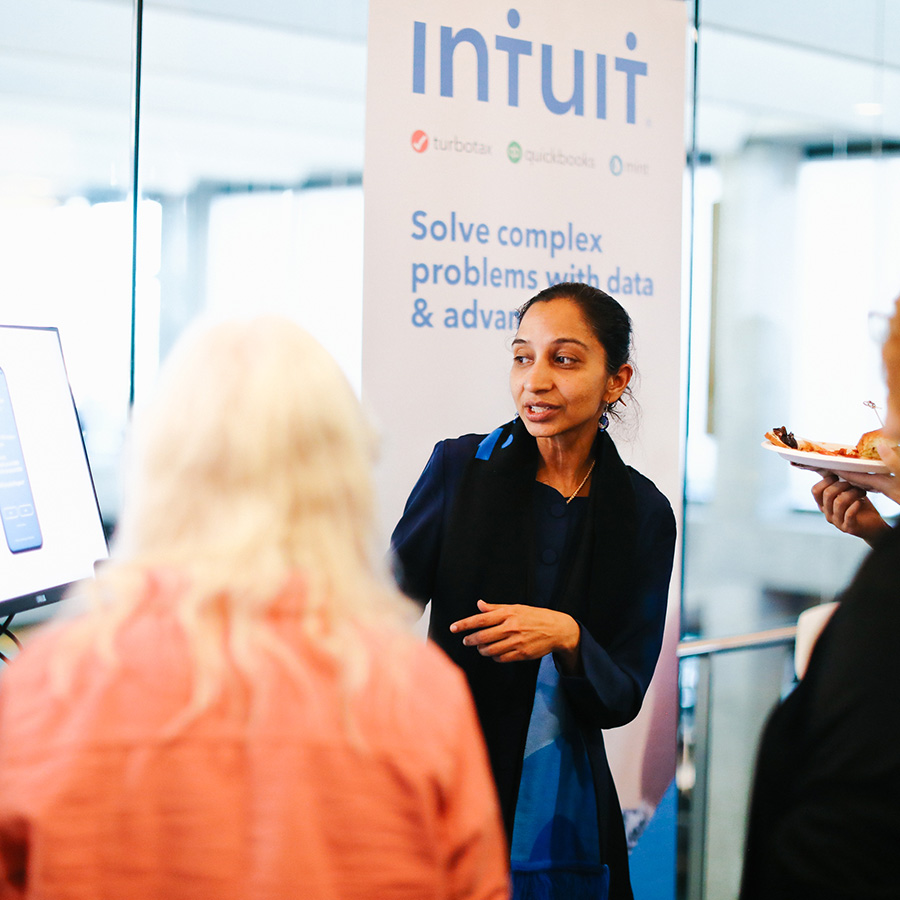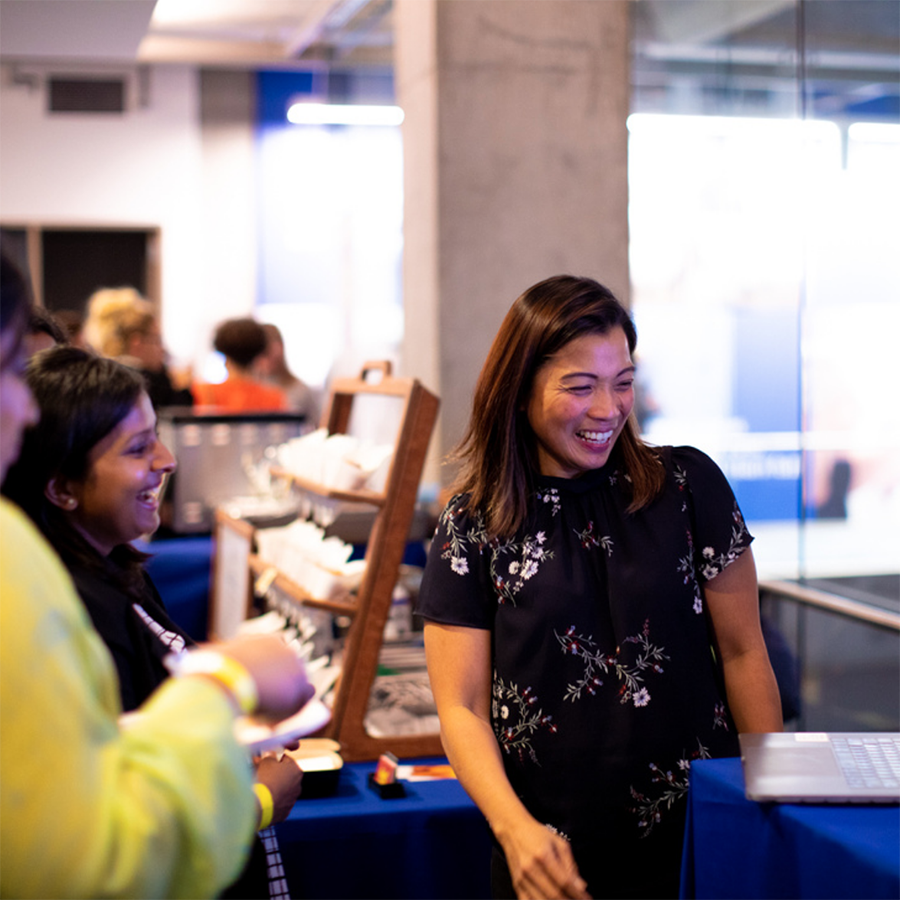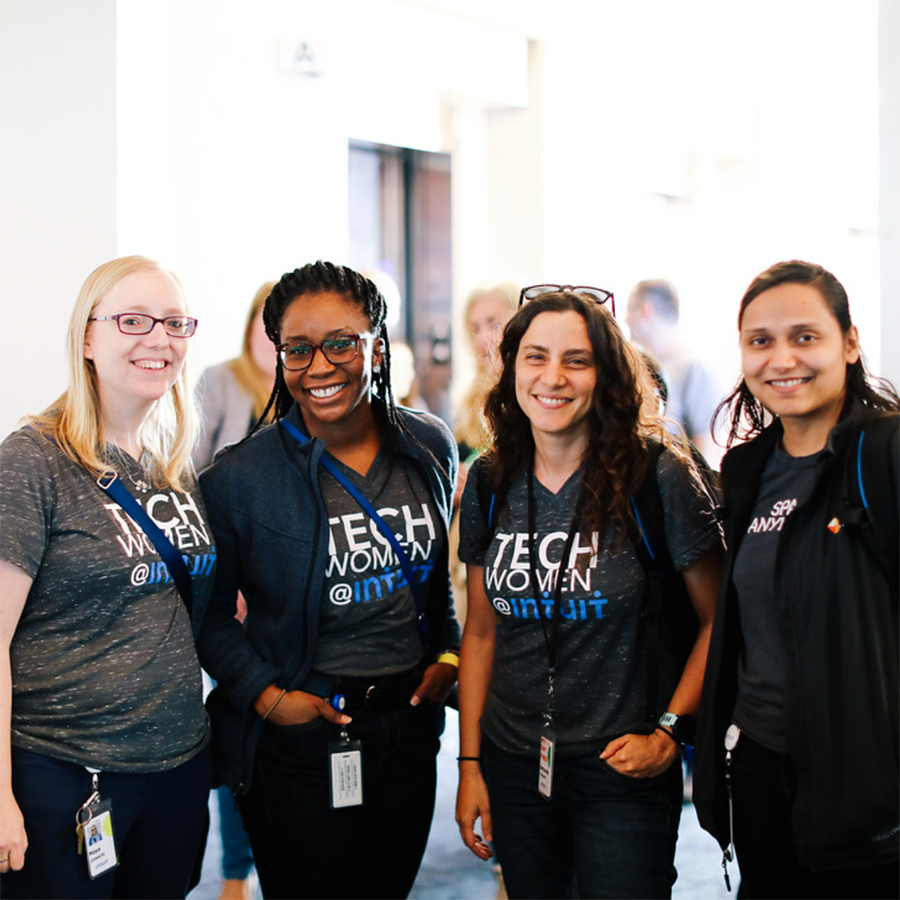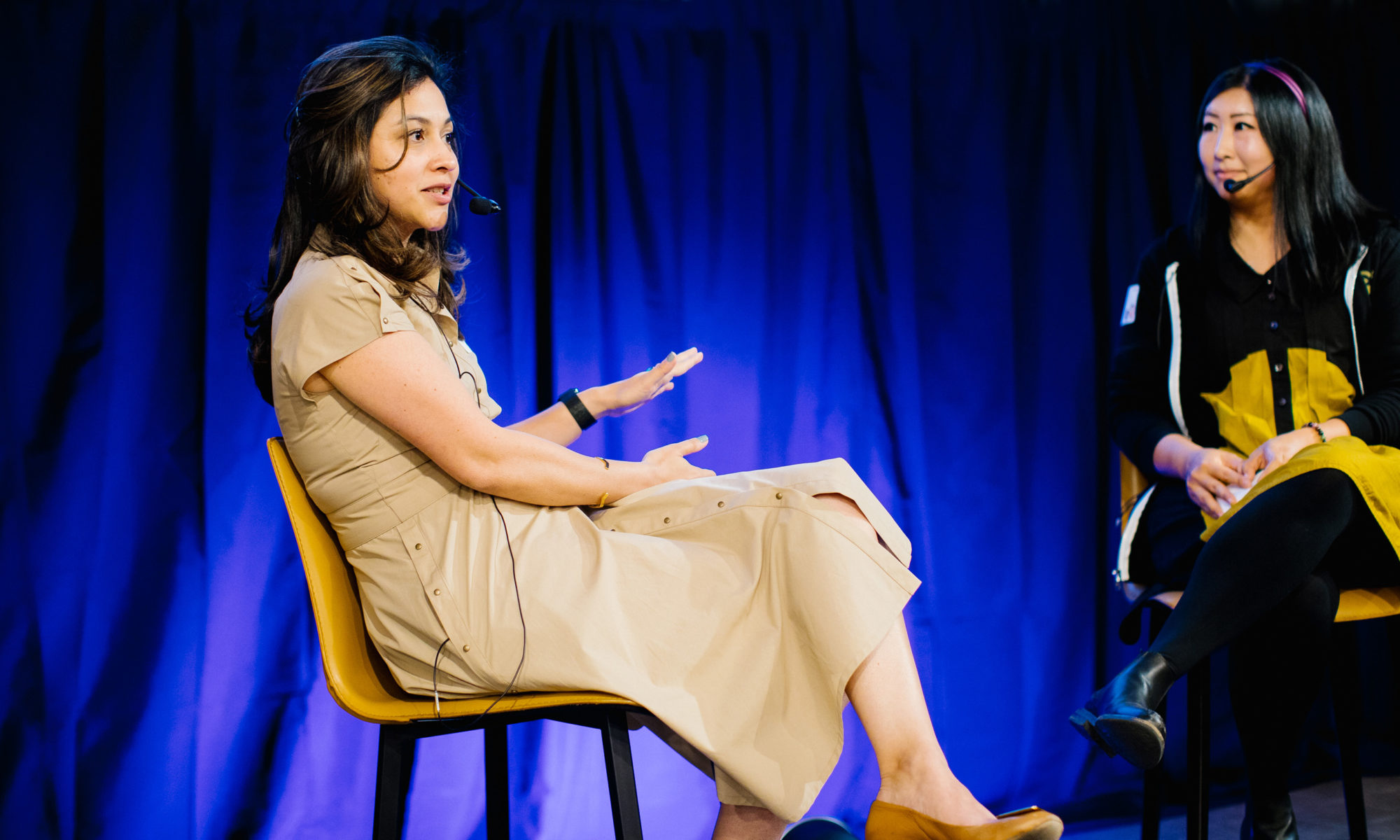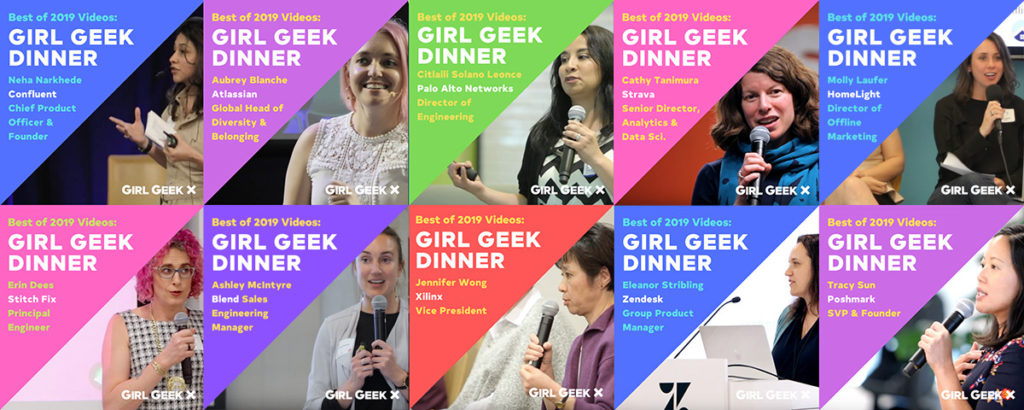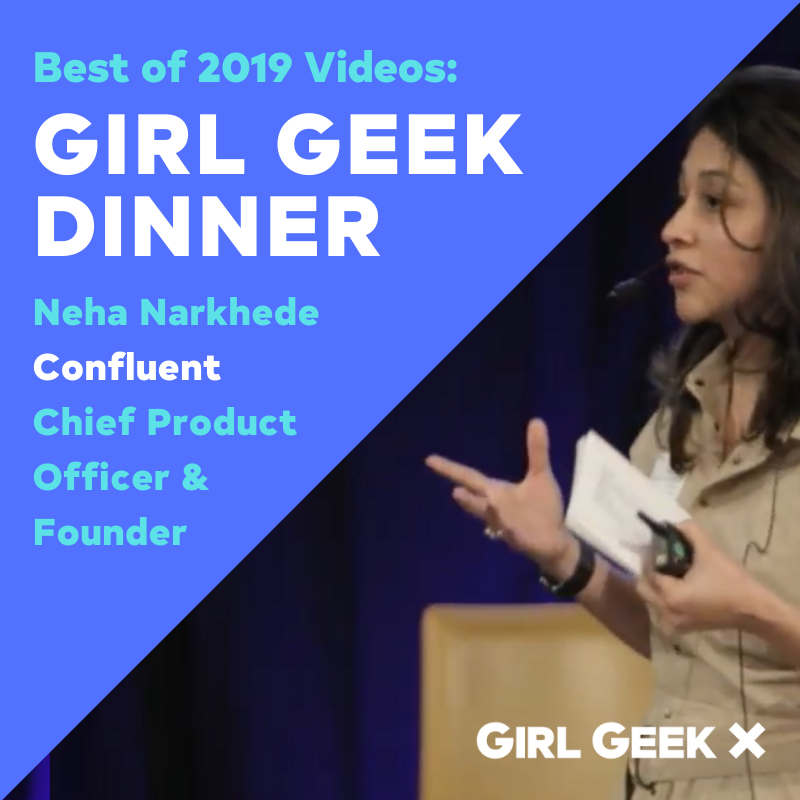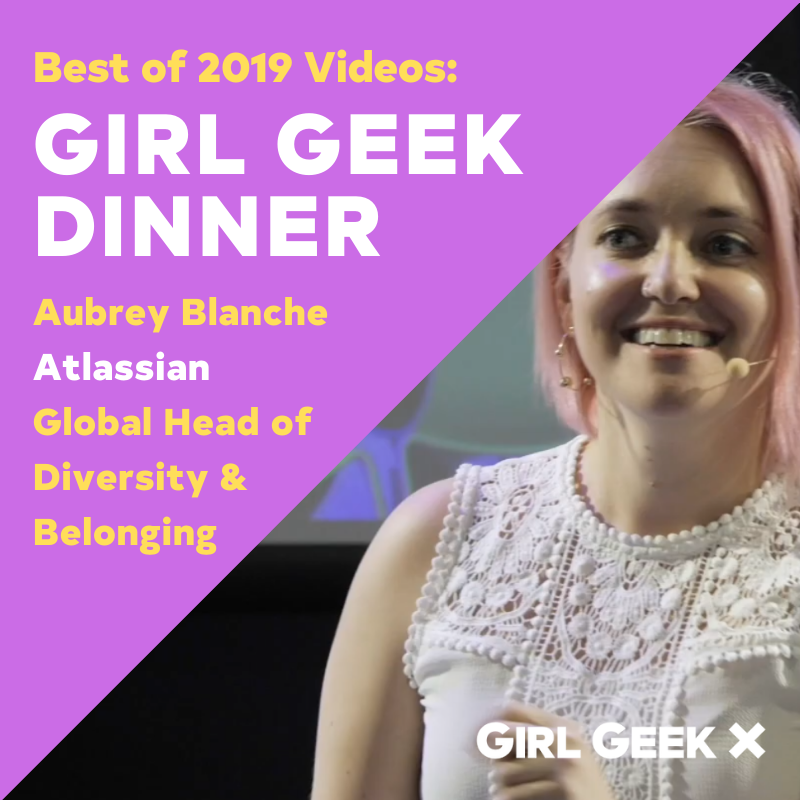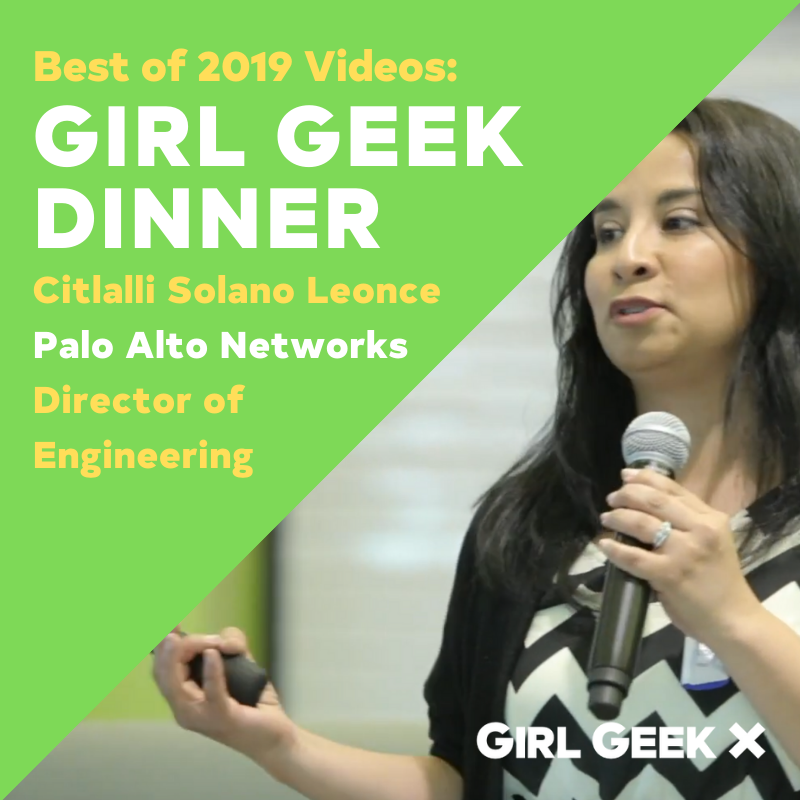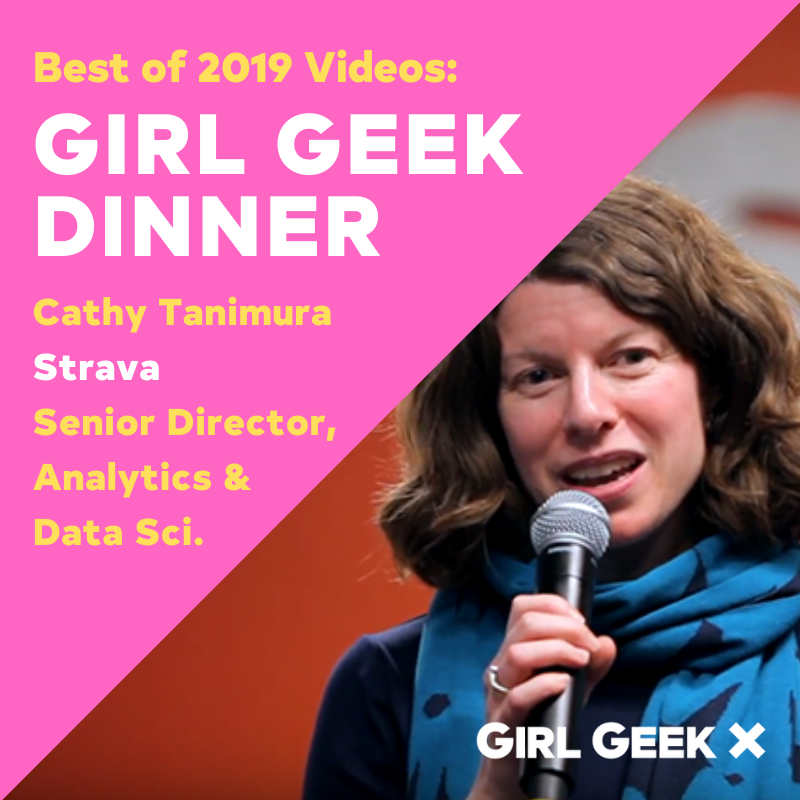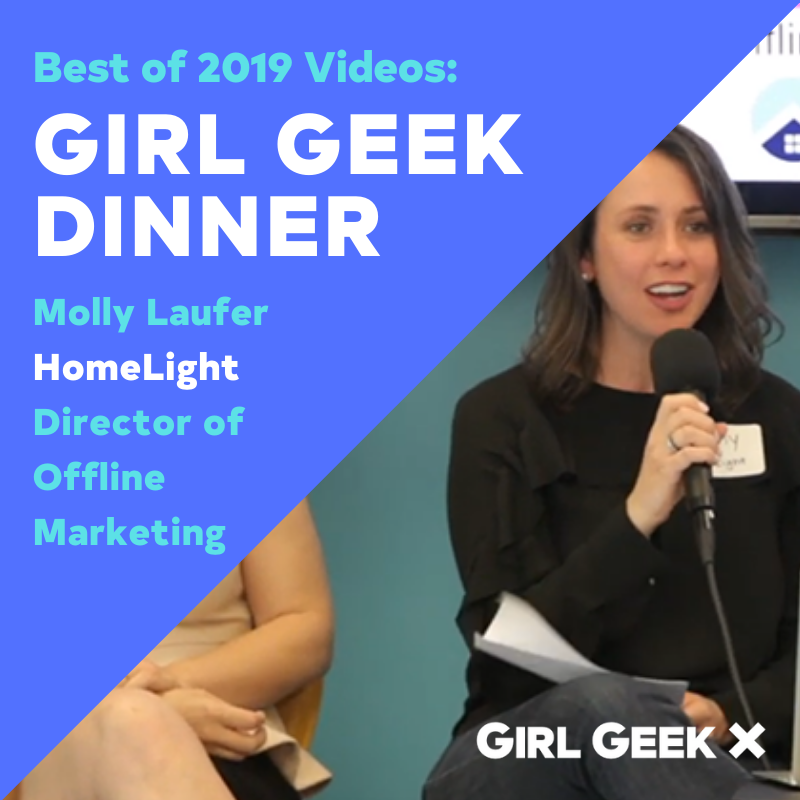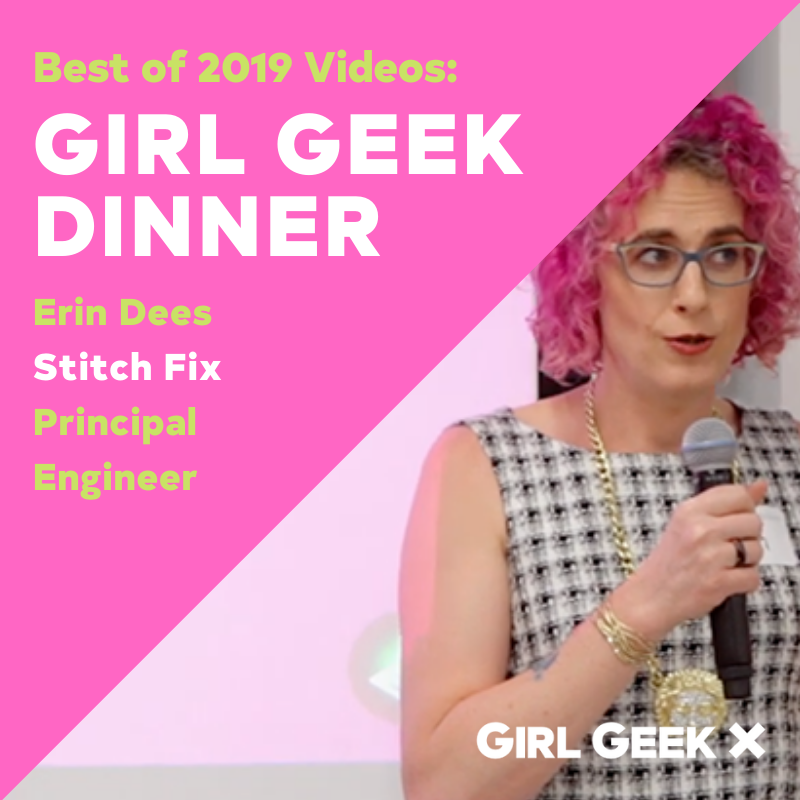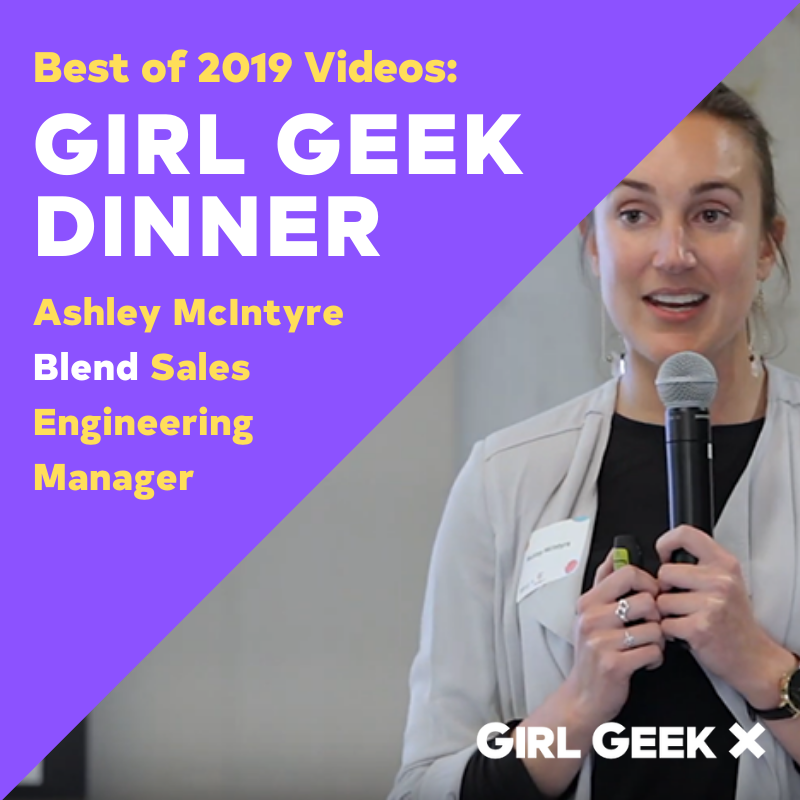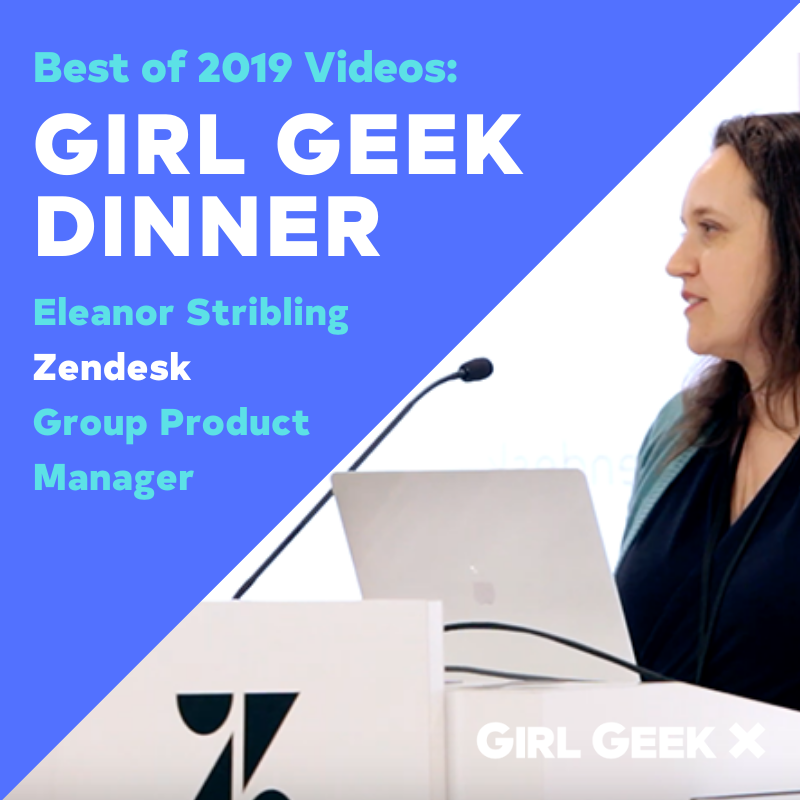Like what you see here? Our mission-aligned Girl Geek X partners are hiring!
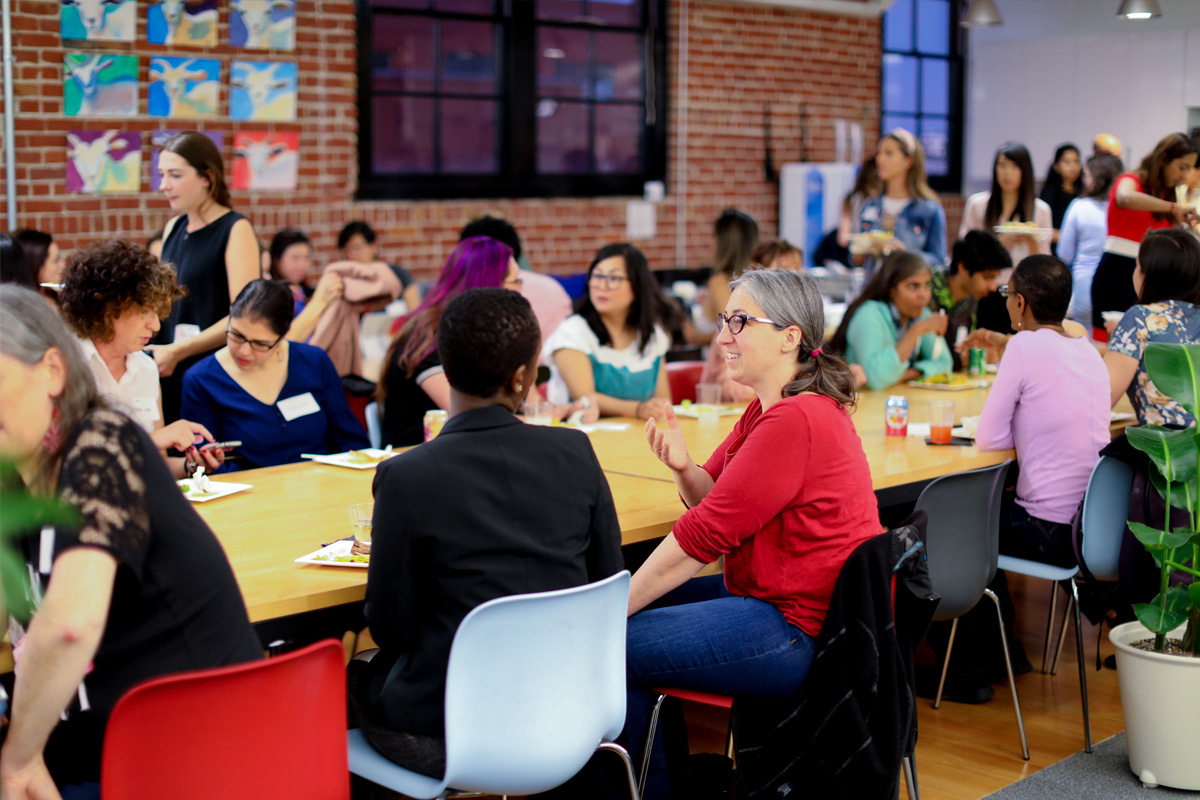
Meeting fellow girl geeks is fun and easy at Mode Girl Geek Dinner in San Francisco’s Design District. Erica Kawamoto Hsu / Girl Geek X
Transcript of Mode Girl Geek Dinner – Lightning Talks:
Heather Rivers: Oh my gosh, there are so many of you here. This is very exciting. Welcome to our very first Girl Geek Dinner, I am Heather. I am Mode’s CTO. Let’s see if we can get the technology to work. Yup, there’s me. Yeah. When I started at Mode, I didn’t have gray hair. This is dyed so long ago. So yeah, really, really excited to be hosting. You may have noticed that the theme for tonight is limitless. That can mean a lot of different things in different contexts.
Heather Rivers: Let’s just do a quick poll, why do you think we chose limitless? This is room of self-selected geeks. I am also a geek. Who here thought we meant the SQL LIMIT keyword. Anyone? Okay, not too many. Yeah, we got some Mode employees, definitely. Okay, raise your hand if you thought we meant the Bradley Cooper media franchise? Yup, okay. Yes, you’re all correct. We meant both of those. We also meant it in a third way.
Heather Rivers: So in 2008, at the Democratic National Convention, Michelle Obama famously said, “The only limit to the height of your achievement is the reach of your dreams and your willingness to work for them.” You’re about to see seven incredible women who fully embody this quote every day. I work with them, so I can say that.
Heather Rivers: Nobody joins a startup because it’s easy. Some startup people in the audience? Yeah. Any of you join startups because it was easy? No? Cool. Yeah, me either. Or obvious, or because success is guaranteed? No, not seeing a lot of yeses there. So, you join a startup because your dreams are high and because you’re willing to work for them. That’s what all of… Oh, it’s lo-res, sorry. Enhance. Enhance. No, enhance. Okay. Technology.
Heather Rivers: That’s what all of these women have done, along with the rest of the team day by day. They took a chance on the startup, they dreamed big, they worked hard, and as a result, they’ve set both themselves and this company on an incredible growth trajectory.
Heather Rivers: So in the six years that I’ve been in Mode, again, the hair. I’ve seen it go from a pre-seed proof of concept, in a super crowded market, by the way, to a simple but promising little app with a few customers, to a real product with traction and revenue, to a leader among data science platforms.
Heather Rivers: And it’s been really exciting to watch us win power users among data scientists and analysts, but we’re not done. There’s still so much more we can do. We don’t have to limit ourselves to just serving data science teams.
Heather Rivers: And that’s why just a couple weeks ago, we launched the latest step change in Mode’s trajectory. We call it Helix. So Helix is an instant responsive data engine that lets not just data scientists, but anyone, run analysis on huge data stats, up to 10 gigabytes at a time. All in the browser, and all without writing a single line of code.
Heather Rivers: Helix lets you explore your data without limits, SQL or otherwise. And I can’t be 100% sure, but I’m pretty sure that’s what Michelle Obama was talking about in her talk. Don’t try to look that up, that’s not verified.
Heather Rivers: So, in one way or another, everyone you’re about to hear from played a huge part in building, launching, and supporting Helix. So let’s give them a huge round of applause.
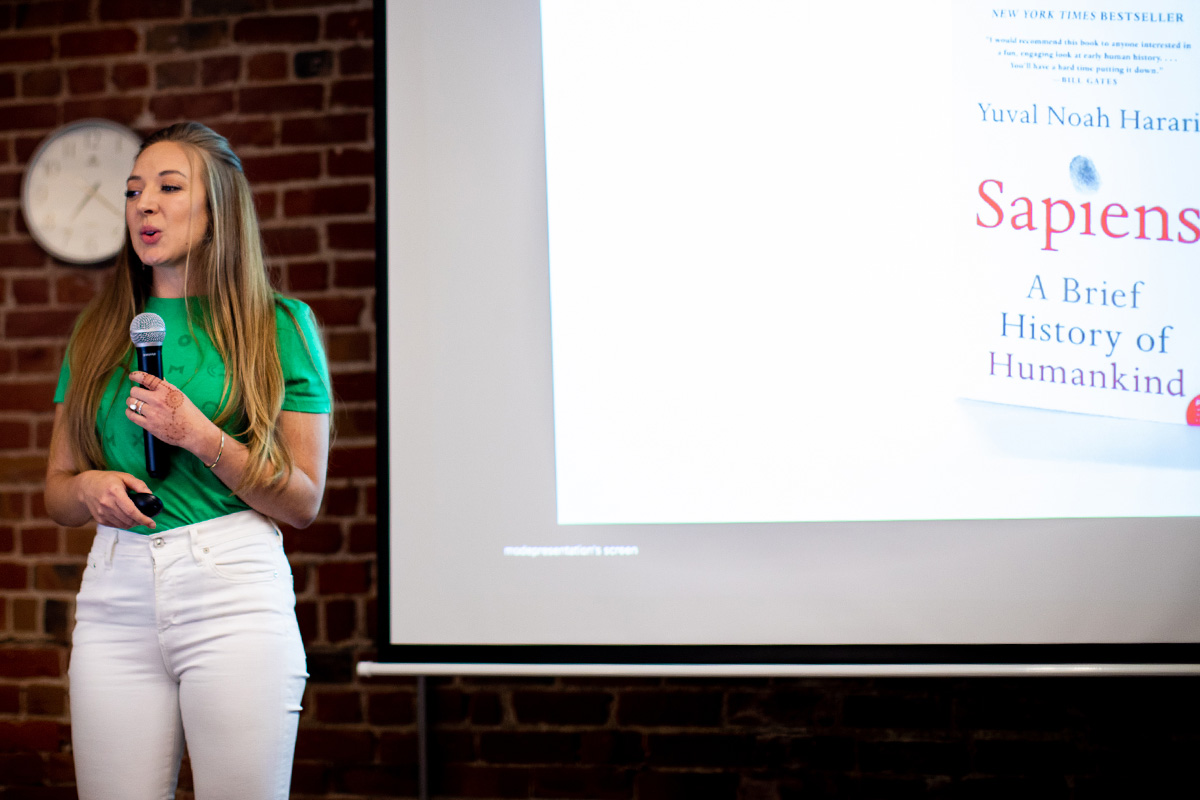
Senior Enterprise Account Executive Kaitlin Hart gives a talk on “Sales is Life, The Rest is Just Details” at Mode Girl Geek Dinner. Erica Kawamoto Hsu / Girl Geek X
Kaitlin Hart: I’m super excited to be here, this is my first Girl Geek. I’d like to kick this off with a really quick question. Who here is in sales, can you raise your hands? Okay. All right. You saw the topic title there, I see that.
Kaitlin Hart: I want to start by exploring why I believe everyone in this room should raise their hands, but first I want to start with a little confession. I’ve been field testing this talk for years, usually in ride shares, as weird as that might sound, but it happened just yesterday. So it’s still very relevant.
Kaitlin Hart: And it happens when people ask, “What do you do?” And I tell them I’m in sales. What happens next is this crash between perception and reality that I get to explore for whatever the duration of the ride might be. Because culturally, we perceive sales to look like this. Or maybe this.
Kaitlin Hart: And we associate salespeople with the traits of being aggressive, competitive, maybe selfish and untrustworthy. And apparently, as men with slicked back hair.
Kaitlin Hart: So while it’s nice to know I’m not any of those things, it’s kind of sad for me to hear because none of these things reflect what I love about sales. In reality, sales to me is much more like this. Two strangers trying to devise a plan. A parent listening to their child’s problems. Or two robots trying to form a relationship.
Kaitlin Hart: I know exactly what you’re thinking right now. These looks like everyday interactions, except the robot part, bummer. And you’re absolutely right. There’s a ton of research on how sales and life are intertwined. Daniel Pink is one of those folks, you don’t have to take my word for it. He wrote a book on it, and he said, “If you spend time persuading, influencing, or convincing others, you’re in sales.”
Kaitlin Hart: So, regardless of what business unit you’re in, you might be a PM, you might be in Dev, you might be in marketing, doesn’t matter. Because about half of your job is still spent on sales related activities.
Kaitlin Hart: So, are you reconsidering yet keeping your hand up? The point here is that sales is just life. You don’t need a special degree. We don’t need to learn any special language. And forget about it being your job title, it doesn’t even need to be in your job description. That’s how ingrained it is into your everyday life.
Kaitlin Hart: Basically, you’re all in sales, and now hopefully you know it, congrats. Comp checks are going to be at the end, [inaudible]. But we’re not going to end there. Because the details are also really important. And what really separates us is how we spend our time and focus. I spend my time focusing on developing interactions and trying to make them more effective. You probably spend your time on something else. And maybe, until one slide ago, you didn’t even know you were in sales. So that’s okay, I’ll give you a pass.
Kaitlin Hart: In the meantime, I’d like to help you get up to speed by sharing some specific skills, aka details, that we know lead to success and growth over time. And I’m not just saying this, we have data to back it up. It’s called revenue. So let’s just dive in.
Kaitlin Hart: The first one is being curious, and this one’s super close to my heart because I was born curious. Over time when I started my career, I realized this was much more of a skill than it was a trait. Because when you approach conversations with a genuine curiosity, people feel that. And when you learn, or when you ask questions that are based on understanding them, and then you listen to their responses instead of thinking about your responses, there’s this feeling of trust that’s built in your conversations.
Kaitlin Hart: And then to take it a step further, you’re going to replace judgment with curiosity wherever possible, and you’re going to avoid assumptions by, again, being curious instead of diving into your assumptions. And this is both for your career and your personal lives. Knowing nothing about someone, this is how you build a relationship rooted in respect right out of the gate. If I don’t know you, but I ask you questions that are thoughtful, and I ask and I listen to understand as opposed to respond, that’s the start to a very fruitful relationship. And then you practice this over time and you see as it grows in other areas of your life.
Kaitlin Hart: Another thing people in sales love, plans. We have account plans, territory plans, comp plans. Name it, we probably have a plan for it. But what we know is that there’s no such thing as a perfect plan. So instead, I like to take the approach of being prepared. Because when you think of being prepared, you can think of it as an outline as opposed to a filled out plan to perfection.
Kaitlin Hart: So, as you outline what it is that you want to achieve and you think about your desired outcomes, think about the how. And then you adjust by collaborating with others, being flexible to changes as they might come, and over time you learn. It’s definitely okay to fail here. That’s part of the learning process. And over time, you’ll naturally learn what leads to more successful plans and you’ll be able to grow from there.
Kaitlin Hart: And then third, we have storytelling. Anyone here read Sapiens? Or listened to the audiobook, that counts. Okay, cool. So basically, Yuval says that stories are the reasons humans rule the world. And he even says that society was built by stories. So look at politics, religion, societal norms. And so without stories, we’d be living in a very different world today.
Kaitlin Hart: But the reason stories are powerful is because they tap into emotion or imagination. Data and facts simply can’t do that. But you don’t have to take my word for it, I have a couple examples for you.
Kaitlin Hart: Here’s an ad that uses facts. Okay, this is a shoe that is breathable and supportive. How does it make you feel? Let’s compare. Here’s an ad that uses a story. Note that there’s no features, there’s not even a product clearly defined here. They’re 100% relying on storytelling and the feeling this imagery plus words are making you feel.
Kaitlin Hart: Maya Angelou actually said it best. It’s not about what you feel, I think I’m missing a slide here, that’s okay. It’s not about what people say that you remember, you remember what people make you feel. And when you think about telling a story, then you should think about how it is that you want to make someone feel. Because there’s a lot of power there.
Kaitlin Hart: And so in order to do that, you just apply this really simple framework. Know your audience, have a clear point, and use either emotion or imagination to deliver a why that connects with the audience. Then you practice. And then you field test, I hear ride shares are great for that. And over time, you’ll discover how to deliver your own powerful stories.
Kaitlin Hart: Ultimately, my hope is that you adopt curiosity, preparedness, and storytelling, and then you develop them over time, both separately and together, to unearth your own limitless opportunities. And selfishly, maybe next time when someone asks if you’re in sales, you’ll raise your hands. Thank you.
Heather Rivers: All right, next up we have Senior Product Designer Sam Novak.
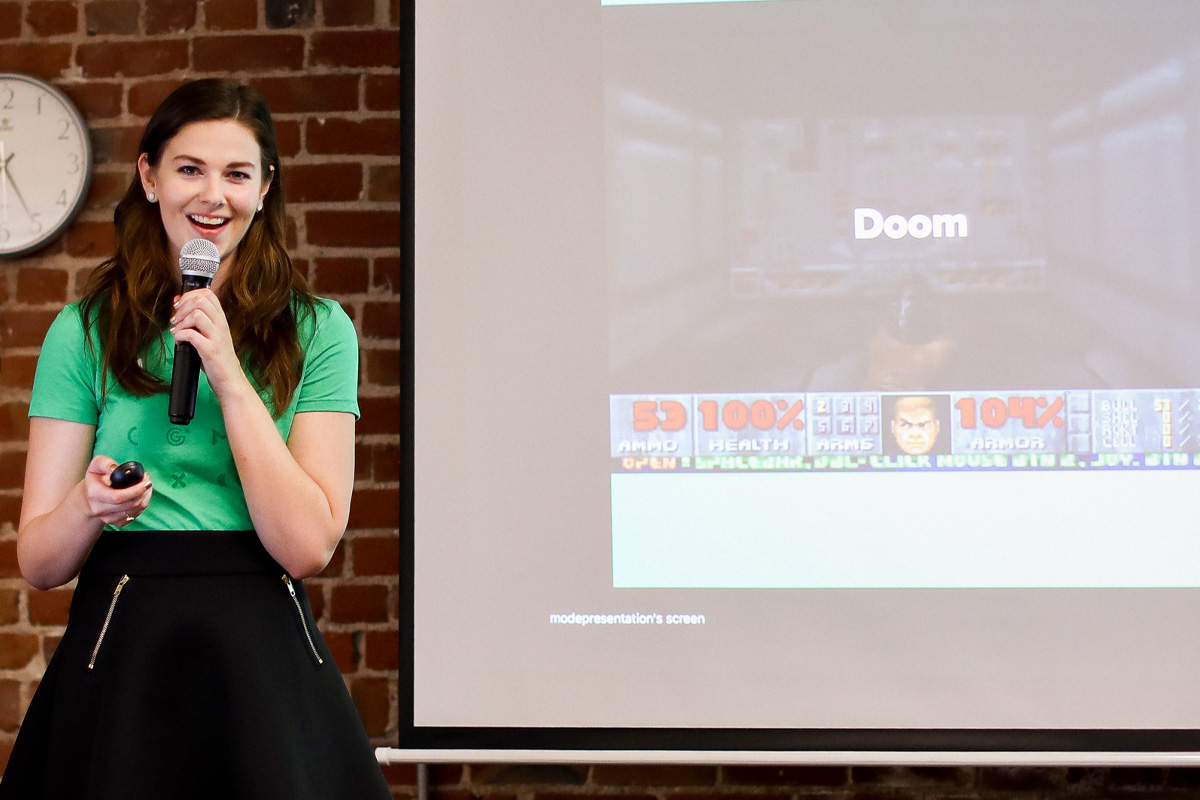
Senior Product Designer Sam Novak gives a talk on “R, Rice Chex, and Re-usable Frameworks” at Mode Girl Geek Dinner. Erica Kawamoto Hsu / Girl Geek X
Sam Novak: Hi everyone. I’m excited to be here today. I’m going to be talking to you about rice Chex, R, and reusable design frameworks. Here’s a photo of me with lots of pixels, but to really set the stage for this talk, let’s go with something a bit more historically relevant. There we go. Let me paint the scene. But be warned, you might need to prepare yourselves for a bit of nostalgia.
Sam Novak: The year is 1996. Pokemon has just been introduced to the world. Independence Day is the largest grossing film. The Macarena is a song and dance beloved by all. And I am almost seven years old. My favorite food is, and I quote, “white rice with butter.” But when I’m not eating buttery carbs, you can find me playing video games on my Windows 95. But alas, this story is not about me. This story is about cereal. Chex cereal.
Sam Novak: In fact, I was merely one of about six million children to fall in love with one of the most ingenious computer game strategies in all of history. That’s right, I’m talking about Chex Quest. For those not familiar, Chex Quest was the largest single mass replication of a CD-Rom ever. 6,000,000 free video games delivered as prizes in boxes of Chex cereal. How did they do it?
Sam Novak: The team was six people. The budget, $500K. The deadline, six months. They were tasked with the objective of creating an educational video game with the ultimate goal of reinvigorating the Chex cereal brand. So they set off to invent a video game from the ground up, to teach users about Chex cereal that kids would want to play. In six months, no big deal.
Sam Novak: The original game concept involved navigating around a cornfield with a flashlight, looking for ghosts. But despite their efforts, the game was just not landing with children. Until leadership came to the team and said, “Look, you’ve got 24 hours to come up with a better idea.” Enter Doom. For context, Doom is a first person shooter game that had been released three years prior. The style of gameplay was really landing with kids, and even today it is still often cited as one of the greatest video games in history.
Sam Novak: Now you may have heard this phrase. “Good artists copy, great artists steal.” Well, the team did just that. They relicensed the Doom engine to build Chex Quest. Now, the Doom team was pumped. They actually thought this was a really creative use of the engine. And the Chex team was happy. It was Doom with a facelift. The gameplay was largely unchanged, and this decision sped up the decision making process tremendously. They were now able to focus on creative ways to make the game nonviolent by redesigning the weapons, and by having the main character, yes a piece of Chex cereal, save the world by sending aliens back to their home planet.
Sam Novak: Everything started to come together. Finally it was time to release it to the world. All six million copies sold out in 6 weeks. Chex cereal sales went up 248%. It received major awards for advertising effectiveness and promotional achievements, and despite a bit of initial heat from video game critics, it developed this huge cult following really quickly. All in all, the project was a hit.
Sam Novak: The thing I love about this story is that the team had no pride or fear around leveraging existing technology. And reusing a style of gameplay that was already resonating with children. And as a result, they ended up creating something pretty inventive and magical. By applying this huge limitation, the results became that much more limitless. “Good artists copy, great artists steal.”
Sam Novak: But what does any of this have to do with modern product design? Well, there seems to be this never-ending debate in design that if you merely copy what others are doing around you, you will never truly innovate. And yet, here lies Chex Quest, one of the most innovative promotional strategies of the 90s. So how can we reconcile these points? How can we take this success story and apply it to modern software development?
Sam Novak: After all, relicensing a video game engine isn’t exactly the same thing as copying an interface, and stealing the user experience workflow. But what if it was? What if we weren’t afraid to get up here and talk about our justifications for stealing, when it led to great design schemes?
Sam Novak: So I’m going to use one more recent example from [inaudible]. The introduction of the [inaudible] notebook interface. I’ll justify stealing from two angles. First, you need to have the right intent. And second, you need a goal of building user trust. Are you ready?
Sam Novak: The timeline for the R project was three months, which was a super aggressive deadline. And the goal was to add support for R, a statistical programming language, in addition to Python while fitting in as many design improvements to the interface and experience as we could. Make no mistake though, this was a redesign of our notebooks. A redesign that would involve a fair amount of stealing.
Sam Novak: So my first justification for stealing is having the right intent. What do I mean by that? Well, you could have argued that our goal was to simply add support for R to our existing UI, but in reality RStudio in IDE was far more popular than writing R in a notebook interface among our user base. So in the same way the Chex team looked to Doom, we stepped back and asked ourselves, why do people love RStudio so much, and how can we recreate some of that passion in Mode? So we asked. Not what features do you like, but what makes RStudio a great experience for you? We documented ideas that were resonating and time and time again, in-app documentation came up as being particularly valuable. So we built in-app documentation. It didn’t matter that our interface wasn’t the same as RStudio, or that they had built documentation first. Adding documentation was just a clear user improvement. Now, the intent here was not to check a box. It was to help both Python and R writers learn about having to leave the context of our notebooks.
Sam Novak: My second justification for stealing is building user trust. Predictability and dependability are two of the largest foundations of building trust with your user base. Now, our old UI resembled a notebook, yes. But it didn’t look or work much like Jupiter Notebooks, the most widely adopted notebook interface. And as a result, the switching costs and the cognitive load, the mental energy required to learn our notebooks increased. It felt different, it looked different, and that difference didn’t necessarily lead to immediate user trust.
Sam Novak: Now, imagine trying to get a ride at the airport in a hurry, switching over from Uber to Lyft and having to learn an entirely new paradigm. But you don’t need to do that, it’s extremely easy to jump between the two. The point I want to make here is that there are workflows and patterns out there that are understood, that are resonating with users. You should have really strong reasoning to completely reinvent something new. Significant change will almost always increase the cognitive overhead required for users to adapt a product.
Sam Novak: What I’m not saying here is that there are never good reasons for introducing newer, better ways of doing things because of course there are. What I’m talking about instead is avoiding an NIH, an acronym that stands for “not invented here” syndrome. Don’t be afraid to reference design patterns that are working well just because you yourself didn’t design them. So, we re-skinned our interface to make it more trustworthy. Better accessibility, better usability, and frankly a familiarity you should come to expect after using other notebook products.
Sam Novak: So in closing, I would challenge you to keep these two justifications in mind when you’re looking to steal. First, don’t just steal for the sake of stealing. Your aim is not to win a feature [inaudible] contest or skip the design process altogether. The goal is to recognize great ideas and innovate on them. Your intent should be to learn and improve. And second, know when to steal. Borrow when it helps to build user trust. By creating something that feels familiar, dependable, and predictable, you reduce both cognitive load and switching cost to your platform.
Sam Novak: And finally for the sake of innovation, I’d like to make one slight improvement to Pablo’s phrase. Good artists copy, great artists steal, but the best artists eat Chex cereal. Thanks, y’all.
Heather Rivers: I will immediately apply the lessons I just learned and steal the mic to introduce our People Operations Partner, Josee Smith.
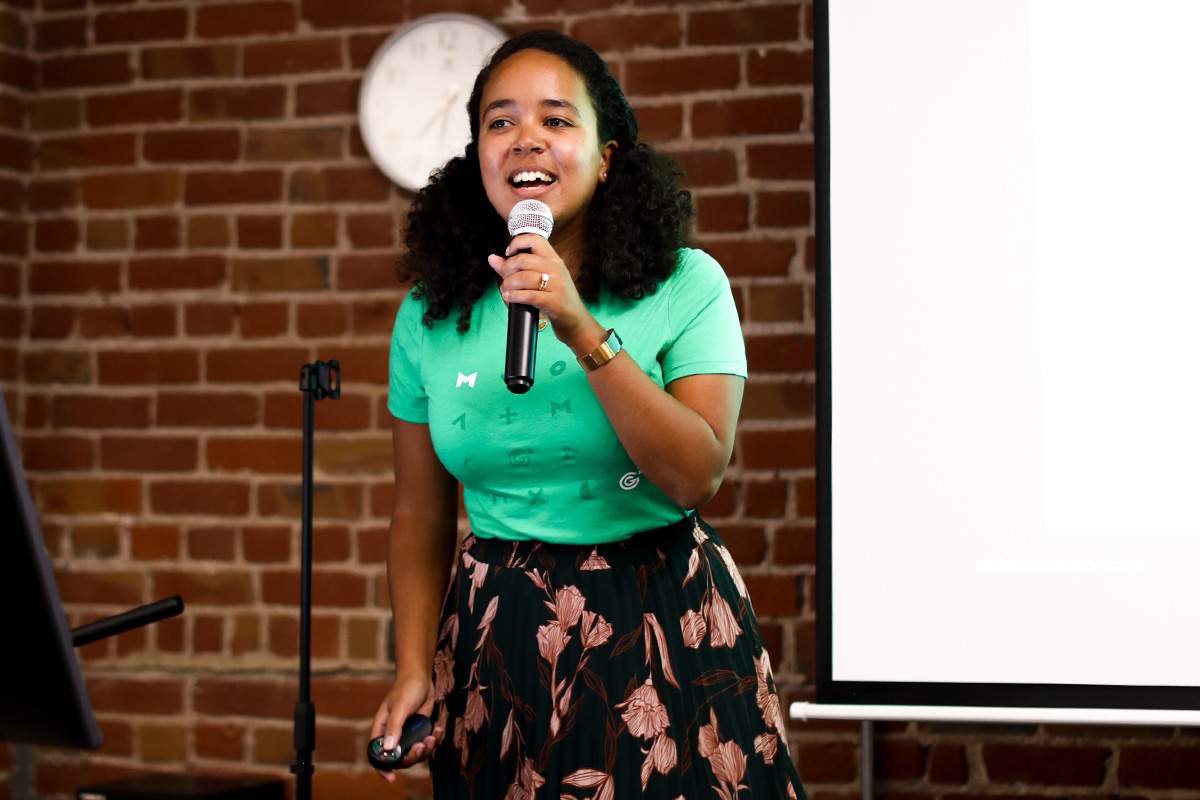
People Operations Partner Josee Smith gives a talk on “How To Ruin Your Team’s Effectiveness in 5 Easy Steps: A Guide To Eliminating Psychological Safety” at Mode Girl Geek Dinner. Erica Kawamoto Hsu / Girl Geek X
Josee Smith: Hi everyone. My name is Josee. As Heather said, I’m the People Operations Partner. Today I’m going to talk a little bit about psychological safety. So here at Mode, I spend my days empowering our managers and building out people programs. In that work with my managers, I bet you all can guess the number one question that I get from our managers here at Mode. How can I make my team less effective?
Josee Smith: Okay, quick story. So, before coming to Mode, I worked as a paralegal at a law firm. And as part of this role as a paralegal, we would have performance reviews every six months with the HR manager. So she would go around to all the different attorneys and ask for feedback on our work, then we’d go over it during the performance review.
Josee Smith: So in the session, she proceeded to tell me about a mistake I had made about four months previously on a project I wasn’t working on anymore. I had some follow-up questions for her, such as was I still making the mistake, did other attorneys think I was making this mistake, or more specific details about the mistake. And she gave me nothing. She had no additional information. And I was really frustrated because here was this person sitting there telling me about this problem, this mistake I had made, but not giving me any information to adjust it or feel like I was being set up for success. I lost a lot of motivation in my work because I felt like they weren’t trying to help me be better at my job.
Josee Smith: So this brings us back to this question. But clearly, this is not what we’re going to talk about today, because no one wants to be less effective or less successful. But I can guarantee that there are companies out there doing things to make their teams less effective.
Josee Smith: So just some ideas of what this can look like. Asking employees for feedback, and then doing nothing with that feedback. Who here has experienced that before? Okay. Making big changes, and then not informing employees affected by those changes. Who’s experienced that? A few more people. My personal favorite. Inconsistent, vague feedback. Anyone, anyone? I think we should all, should all put our hands up. Because I think this is something, it’s a serious problem. A lot of us have gone through some of these things. I’ve experienced a lot of these things, including at the law firm, and I’m no longer at those companies because these actions not only make teams less effective and less successful, but they’ve been shown to drive away diverse talent.
Josee Smith: We’re a values driven team here at Mode, and underlying a lot of those values, there’s this idea of psychological safety. So, for those who haven’t taken a psych 101 course or if you don’t work in HR and think about this all the time. Psychological safety is created when team members feel comfortable taking risks and being vulnerable with each other. Here at Mode, we also see it being created when team members feel comfortable bringing their whole selves to work. Of course, in a way that is respectful of their teammates.
Josee Smith: A climate of psychological safety makes it easier for people to speak up and share their different thoughts and perspectives. And not feeling comfortable sharing your thoughts, or not feeling safe in that environment to speak up, can be a powerful barrier to collaboration and good decision-making. Psychological safety is particularly important in regards to underrepresented groups as a lack of the safety can lead to the kind of undermining behaviors that can drive these groups out of tech, such as feeling excluded from meetings or social events, feeling talked over, or feeling like your thoughts and perspectives aren’t being heard.
Josee Smith: A lot of research has been done on this topic, including a 2015 report from Google summarizing their findings from a two year study of their highest performing teams. And so I’d like to go over some of those traits. At a high level, successful, psychologically safe teams foster curiosity. So just encouraging teammates to study topics outside the scope of their role.
Josee Smith: Taking and encouraging risks. Skydiving, that is me up there. It doesn’t always have to look like skydiving, of course. It can be starting a new project that might fail for the sake of learning from it.
Josee Smith: Promoting respect throughout your company and your team and being thoughtful about how teammates talk about each other. And it also looks like encouraging candid conversations, such as managers asking employees for feedback and then actually doing something with it.
Josee Smith: So, as I mentioned, we’re a values driven team here and I see psychological safety being created through some of those values. I’d like to focus in on one specific value that has been instrumental to my success here at Mode. Honest words, kindly delivered. So I’ve been at Mode for about two and a half years. In that time, I’ve had the same manager, her name is Bailey. Maybe you’ve talked to her tonight. And one of the many great… Obviously one of the many things I can count on from her is consistent, constructive feedback. I know that as soon as I make a mistake, but also as soon as I’m doing really well, she’ll tell me about it because it’s important for her, it’s important to her to make sure I understand how my performance is doing. And that makes me really happy. My performance is not a secret to be talked about every six months.
Josee Smith: Okay, so, you might be sitting there and thinking, “Well great, Josee, that’s excellent for Mode. So happy for you that you found this place, but how do I practice it? How can I go about creating a more psychologically safe team?” Don’t worry, I have some tips. Here at Mode, we make it a habit of appreciating when someone is vulnerable. It can be hard to express yourself and take risks, especially if you don’t know how it’ll be received. So, when someone speaks up in a meeting when they’re normally silent, or if someone says they’re nervous about a project or presentation and then they go in and then absolutely crush it, give them some kudos. Let them know that you appreciate their efforts and you’re proud of them for stepping outside of their comfort zone.
Josee Smith: So I learned this next tip from Heather, actually. She’s somewhere. Oh, there she is. Be mindful about meetings. Not everyone likes to speak up during meetings, nor should they have to. So pay attention during meetings to who is and isn’t speaking, what is and isn’t being said, and encourage your teammates to expand on their thoughts. Consider sending a follow-up message after the meeting summarizing your thoughts, and asking your teammates to chime in with their opinions. You might unearth a perspective that didn’t come through during the meeting, but could be vital to the task at hand.
Josee Smith: So in my experience, the number one way to create a psychologically safe environment is to change your mindset around failure. To some, failure is the worst possible outcome and something to be avoided at all costs. In a psychologically safe environment however, failure can instead be viewed as a stop on the road to success or as something to learn from. So, when considering how failure plays out in your own work, don’t view it as something to be avoid, just the worst thing that could possibly happen. But instead, think about how it can be something to learn from or how it can get you one step closer to the right solution to a tricky problem. Sometimes, you have to fail to get there.
Josee Smith: I encourage all of you to think about how psychological safety plays out in your current workplace. Do you think you could bring up the topic or these ideas with your manager? If you don’t feel like you could bring this up because you think your manager won’t listen, or you worry they’ll think you’re a low performer for caring about this subject, think about how, what kind of workplace you’re going to thrive in, and what role psychological safety will play for you, like I did at the law firm. And, if you feel like you’re not getting anywhere, that your manager isn’t listening, lucky for you, Mode is hiring. Thank you.
Heather Rivers: We have one last talk before a quick break, and this is from Back-end Engineering Manager Max Edmands.
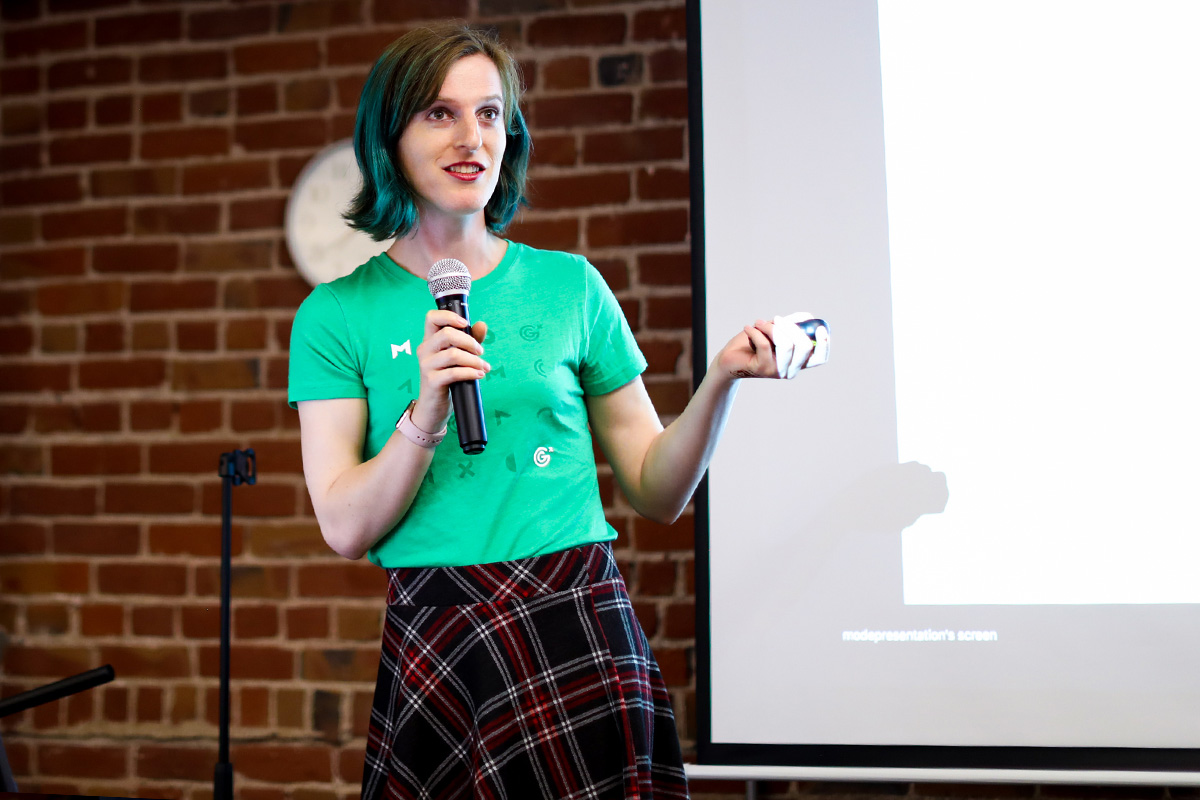
Backend Engineering Manager Max Edmands gives a talk on “Constructing Feedback Loops for Fun and Profit” at Mode Girl Geek Dinner. Erica Kawamoto Hsu / Girl Geek X
Max Edmands: Hi. This is me, kind of. It’s a really pixelated version of me. This is an animation of someone pouring milk for a cappuccino, but this talk is not about being a barista. This is actually a talk about feedback loops. So, I want to start by breaking this term down a little bit.
Max Edmands: Feedback generally means conversations between humans. Someone noticing something about what you’re doing and giving you an opinion about it. Totally true, but feedback is actually more than that. Here is an example of extremely valuable feedback. As the barista’s pouring, they can see and feel the results of what they’re doing. Are they keeping the espresso crema intact? Is the milk the right ratio of liquid to foam? Is the pattern on the top of the milk glass the pattern they wanted to create? Are they filling the glass to top? Is everything the right temperature?
Max Edmands: All of this can be generalized into three attributes for great feedback. One, great feedback is high bandwidth. Lots of information coming in as quickly as possible. There’s the weight of the cup and the milk jug. There’s the temperature of the liquid in the cup. There’s the pattern that the milk is making on the surface. There’s the sound that it makes when it’s pouring. There’s so much there.
Max Edmands: Two, great feedback is relevant. There’s very little distraction here. Everything is signal and there’s no noise. You’re seeing it and you’re holding it, and all of the senses you’re getting are relevant.
Max Edmands: Three, great feedback is timely. It’s actually all in real time. The barista can change the angle of the cup and immediately they see a change in the surface area of the crema and the resulting change in the milk pattern they’re creating. So that’s feedback.
Max Edmands: Now let’s talk about feedback loops. A feedback loop is when you can take the feedback you got and try to use it again, or sorry, use it to try again. But this time, a little bit more effectively. And then use the results to get more information and then do it over and over again.
Max Edmands: So, there are a lot of great examples of feedback loops in video games. This animation is from a game called Celeste. Definitely recommend this game, by the way, it’s super great. Every feedback loop follows five steps.
Max Edmands: So step one, identify a goal. In this case, the goal is get the strawberry and bring it to the top left hand, right hand corner of the screen. Two, take concrete actions toward that goal. So jump on the block and ride it to the other end, and then try and jump off of it onto the platform and, oh no, falling into the spikes. So three, step three, evaluate your feedback. Ask yourself questions like, what did I learn just there? In this case, really clear information, if you jump in that way, then you’re probably going to fall onto the spikes and that’s bad.
Max Edmands: So then four, adjust your approach and try again. Maybe this time let’s try a dash jump when we’re in the air so we jump a little bit higher, so we can get onto that platform. And then see what we can do when we’re up there. And it works. Cool. Do it over and over again until we reach the goal. But now we’re on the platform, we have to figure out what to do next. So now, probably, we’re going to start a new feedback loop with a slightly different challenge. Great. So that’s games.
Max Edmands: But what about stuff you’re probably doing every day? Here’s an at-work example for those of you who write code. Test-driven development. So, here we have two sides of the screen. One of the sides has test results, and the other has the code. We’re adjusting the code in order to make the test suspect something that isn’t true yet. Then, we’re adjusting the code to make the test pass again, and then repeat. We know that something’s, I guess, needing to be fixed when stuff is showing up in red, and we know that stuff needs to be made to fail once stuff is showing up in green. It’s a very clear set of what do I do next.
Max Edmands: There’s another, smaller loop going on there too. As we’re editing the code, the editor is underlining certain things in red to let us know that the syntax isn’t quite right. The moment that we finish typing a line, or the moment we fix the syntax error, the red goes away to let us know it’s fixed. And then repeat.
Max Edmands: Working together with other humans is another great way to create an immediate feedback loop. I think this is a super cool photo. Two early programmers, collaborating on one of the world’s first computers. Early pair programming. I’m not 100% sure what they’re doing here. In my imagination, Esther is holding a specification that says what patch cords need to be connected to which ports. She’s reading the list out to Gloria, giving her time to connect or verify each one, and probably doing a visual check too just to make sure. Esther’s also got a bundle of extra cords ready for when they move onto the next one.
Max Edmands: So together, they’re able to keep track of where they are and move from one step to the next. They’re much more likely to notice and correct mistakes early. They’re somewhat less likely to get distracted, since they’re both concentrating on the same thing at the same time. And they’re way more likely to come up with new approaches or make adjustments to their process as they go.
Max Edmands: Which brings me back to conversational feedback. Retrospectives, one on ones, coffee walks. Words are an incredible way to fit lots of information into a really small space. Setting up regular places to have more of those conversations between either teams or between individuals, you and your manager, you and a peer, gives you way more opportunities to get and give feedback.
Max Edmands: So, how do you go from no loop to a feedback loop? Well first, we have to define the goal. Let’s say I want to draw an owl. So, now we need to figure out how we’re going to do it. I already have a process for drawing an owl. It’s something along the lines of flail along the page with a pen for a while and use a lot of white out. Eventually we got somewhere interesting. If I put it on a timeline, it might look something like this.
Max Edmands: So, next up is we identify specific decision points that’ll get us there. In this case, every time that I’ve scribbled on the page a little bit, I take a step back to figure out where to start adding the next round of details. But which details specifically should I add? This is the perfect place to start getting feedback. So, what feedback would be good here? Feedback could be comparing it against another implementation of the goal and figuring out what tweaks to make. It could also be user testing. Show your picture to another human, ask them what they think. It could also be, try to sell it and see if people will buy it. Would you buy this owl?
Max Edmands: Then iterate. Keep thinking of ways to increase the number of decision points and increase the quality of the feedback you’re getting at each point. Warning though, make sure that the additional process you’re adding is worth the cost you’re paying for it. Too much process is busy work. Nobody likes busy work. Too little process is confusion, doing the wrong thing. There’s a really fine line between the two, and staying in that balance itself is actually pretty tricky. Which is why I recommend, build feedback loops out of the quality of your feedback loops.
Max Edmands: It sounds like a joke, but I’m being completely sincere. The best way to figure out if you’re balancing cost versus benefit of process is to think about the process in exactly the same way that you’re thinking about the thing that you’re doing. Be continuously learning if there’s too much or too little, and be continuously adjusting as you go.
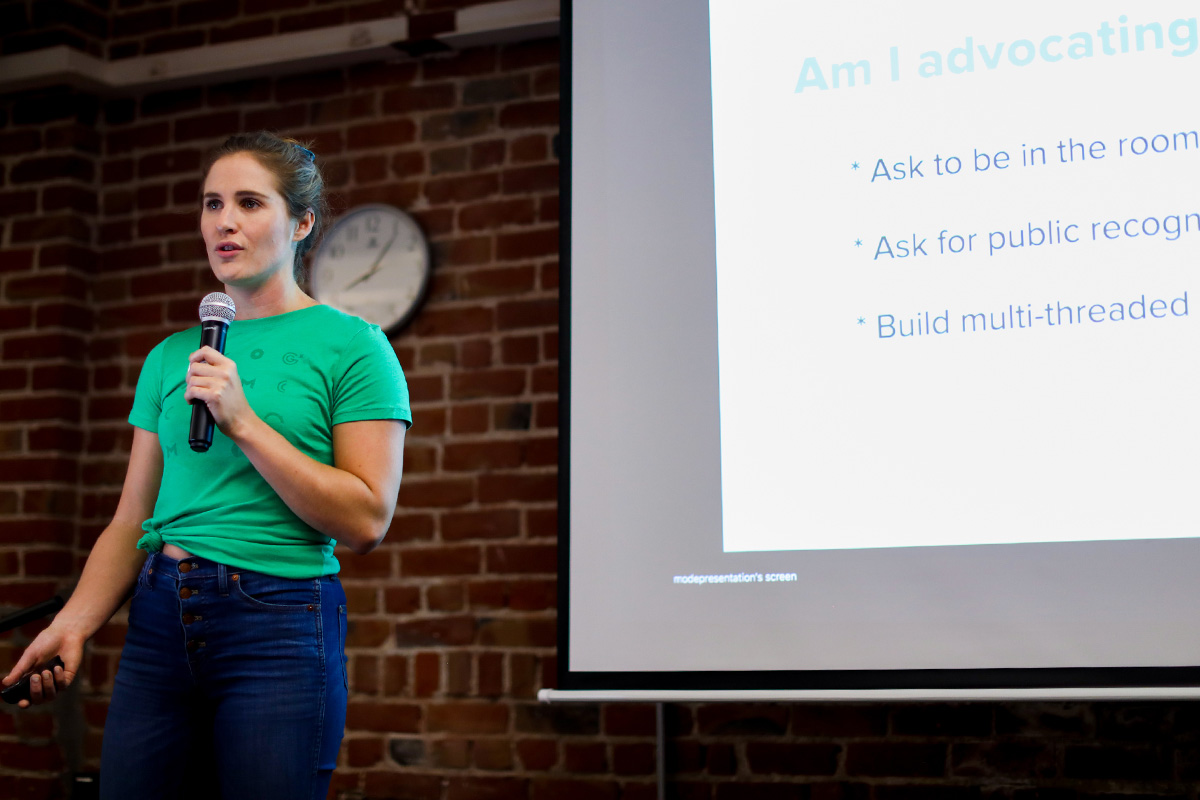
Senior Manager, Business Strategy & Operations Christin Price gives a talk on “Ops, Table for 1” at Mode Girl Geek Dinner. Erica Kawamoto Hsu / Girl Geek X
Christin Price: Hey everybody, thanks for coming out tonight. I am Christin Price, and I work in the finance and operations department at Mode. Tomorrow actually happens to be my two year anniversary. So, I joined Mode shortly after we raised our series B and I was our first in-house finance hire. And that sounded extremely cool to me.
Christin Price: So at the time, Mode was experiencing some of the typical growing pains you might see at a series B startup. For example, we’d grown out of our office space. At the same time, I was going through some of my own growing pains. I was getting whiplash from how quickly my job title kept changing. I went from leading an annual planning cycle to doing a deep dive audit on a revenue number to prepare for a series C, and I even inherited a sales ops function.
Christin Price: As these demands kept mounting, I felt like I always needed more time or more people to get anything done. Everything felt like a fire, and I didn’t feel like I was getting to do my best work. As this persisted across multiple months, I began to wonder if I’d made a mistake. My career trajectory felt like it was getting buried under the number of tasks it took just to keep the lights on.
Christin Price: Historically, I may have taken this as a sign that Mode wasn’t invested in me. And a mentor challenged me on this line of thinking. She asked me if I knew what the difference was between a fixed mindset and a growth mindset. A fixed mindset was believing that the situation was permanent, and that I had no power to influence or mold it into something different than what it was. Whereas, a growth mindset was to develop a true love of learning and believe that the best learning opportunities are presented through challenges.
Christin Price: Here are some examples of fixed versus growth mindset. Wow, that feedback really hurts my feelings. I’ve been working on this for months and clearly I’m not valued here. Versus, that’s an interesting perspective this person brings. I wonder if I incorporate that feedback into my work how it will change my work product. Or, I’ve never gotten along with this person and we just shouldn’t work together. Versus, these are this person’s strengths and these are my strengths. I’m really interested on iterating on them together to figure out how we can best work together.
Christin Price: So tonight I’d like to share a framework with you that I use to develop a growth mindset while also ensuring my career trajectory doesn’t get buried beneath the day to day. First off, do I have an executive sponsor? A mentor is someone we rely on and learn from their experiences to shape our own viewpoint. A sponsor is someone who will fight for us behind closed doors. I encourage you to ask your direct manager to be this for you. Ask them what would it take for you to have zero hesitation fighting for me?
Christin Price: The second question I ask is, am I soliciting continuous feedback? Y’all, feedback is exceptionally hard. Sometimes I feel like I’m walking to the edge of a cliff and asking someone else to push me off. But, with time and practice, I’ve gotten quite comfortable being uncomfortable. The best way to solicit feedback is to make a verbal contract with everyone you work with. Say, “I’d like to solicit ongoing feedback. Are you able to do this?” And then as you work together on projects, check in frequently, and I’m talking a couple times a week, and say, “Hey. What do you think is going well and what could I be doing better?”
Christin Price: Am I advocating for myself? As a society and especially as women, I feel like we’re pre-conditioned to believe that hard work in and of itself pays off. And I haven’t found this to be particularly true. Now that I’m comfortable being uncomfortable, I practice stepping outside my lane. I ask to be in the room.
Christin Price: Last month, there was a strategy meeting about how we hit our revenue number for the remainder of the year. It was 8 pm on a Tuesday night and I was asked to put together a model for the meeting the next day. I did so and I got my boss up to speed on it, and then I thought, “I have a valuable contribution here and I’m an expert on the subject.” I asked to be in the room. Not only did I join the meeting, I ended up leading it and one of our co-founders chased me out of the room with follow-up questions. It ended up being one of my most productive meetings in my two years at Mode.
Christin Price: Asking for public recognition. This past spring, I did a reboot on our commissions policy for our customer success function. And it took a lot of hard work, and the head of that team thanked me, privately, for the work I’d done. I asked him if he’d stand up at our Thursday all hands meeting and give me that recognition publicly. Not only did he agree to this, he thanked me for asking him. These small asks will increase your exposure to others within the organization, and also increase your level of influence.
Christin Price: Building multi-threaded relationships. This is actually a sales strategy. Imagine you’re working a deal, and your single point of contact leaves the company. It makes that inherently risky. Similarly, by building multi-threaded relationships with all different people at all different levels and in all different departments of your company, it ensures that there’s no single point of failure. Our CEO left on maternity leave earlier this year. If I relied exclusively on him to give me a voice within Mode, I would’ve been starting from scratch. Instead, I had many strong relationships to lean on during that time.
Christin Price: Don’t try to be everything to everyone. I had an epiphany about a year ago. I have always considered myself a direct person who establishes clear boundaries, but reflecting on my time, I’d realized I was trying to prove my worth by being a yes woman. Telling people I need more time, or that a project isn’t high priority, and then subsequently not doing all of the late work necessary to find that project a home is a really good practice. Others respect my ability to prioritize, and more importantly, I have the energy to bring the intellectual and emotional intelligence to the work that does fall within my purview.
Christin Price: Am I giving myself room and grace to make mistakes? I had a pretty serious miscommunication with a senior leader at Mode. Instead of accepting that I burned that bridge and beating myself up over it, I decided to apply a growth mindset. I apologized, I collected feedback, and I incorporated that feedback to rebuild our relationship. Today, I can gladly say we have a great working relationship. And furthermore, I don’t regret that mistake because of how much learning I got out of it.
Christin Price: So yes, this framework is a work in progress and yes, it takes serious energy to execute on it every day. And no, by no means have I mastered it. But I choose to apply a growth mindset and believe that with time and practice, I can continue to improve. It will become second nature. And I do truly believe there is something to be learned from every situation, especially the tough ones. And every day, I see the dividends of this practice.
Christin Price: Today, I am no longer on an island, as other people have joined the department. I was promoted to be a people manager, and I even have two open recs to continue growing the team. So, if you are a pace setter with a growth mindset who is hungry to learn and step out of your lane, Mode rewards that. And come find me after, because I want you on my team.
Christin Price: So today, I’m glad to say my relationship with Mode is mutually beneficial. It’s both give and take, and my career trajectory continues to crystallize. And with my growth mindset, I see limitless opportunity.
Heather Rivers: Next up, we have Senior Product Manager Nishi Patel.
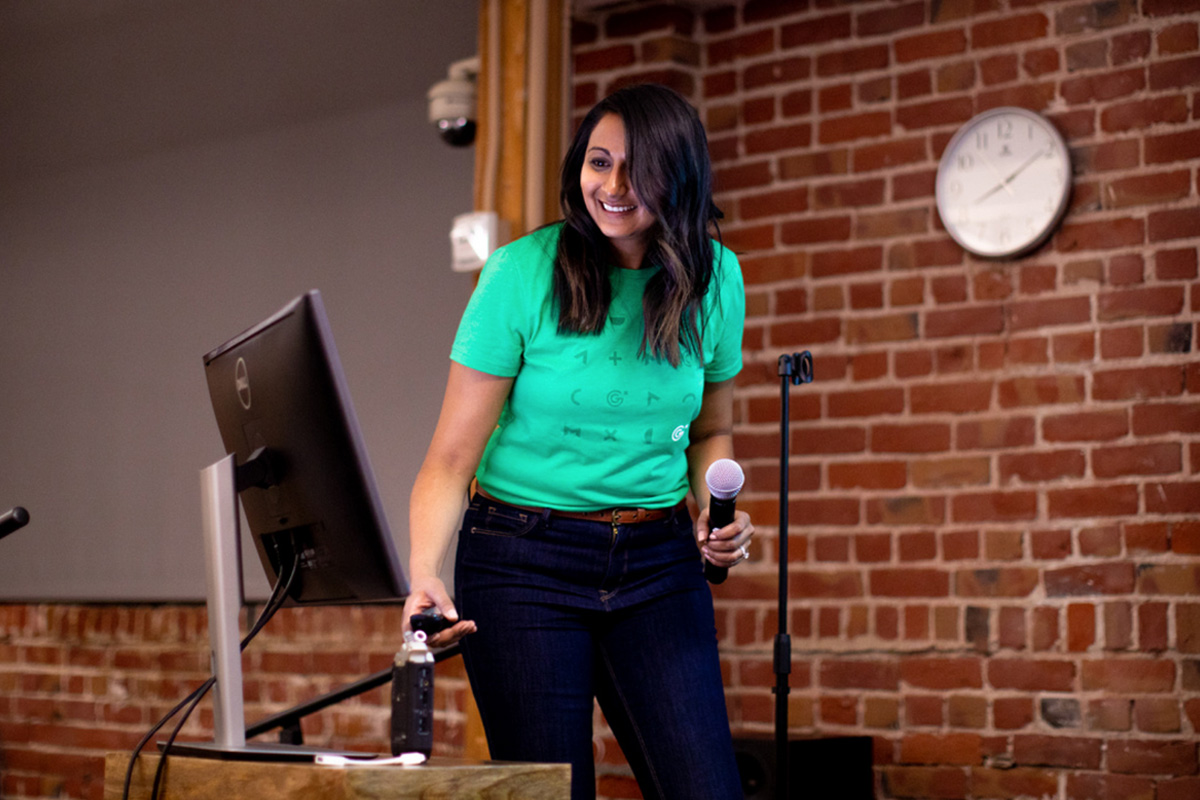
Senior PM Nishi Patel gives a talk on “Limitless Success: Influencing without Authority” at Mode Geek Dinner. Erica Kawamoto Hsu / Girl Geek X
Nishi Patel: All right, hi everyone. As Heather mentioned, my name is Nishi and I’m a PM here at Mode. I’m going to start off with a little story. So, it’s 2013, I had just landed my first PM gig after many interviews and I was so excited. I was bright eyed, bushy tailed, had done all of the reading I needed to do, and walked in on my first day. Within the first few weeks, I had been given the perfect project for our team. I’d been working with the design team, the engineering team, we’d done customer research, we’d built a bunch of prototypes, done testing. And we thought we had the ideal solution to bring our company’s first app to life.
Nishi Patel: So, in the following weeks we were going to have our first planning meeting. The CEO was going to be there, there was going to be a lot of stakeholders, some people that I hadn’t really even talked to yet. But I felt really confident in our solution and I was ready for it to be applauded and praised, and just feeling really good about it. What actually happened was that the CEO, amongst others, questioned every single point that I brought up. He pretty much shot down every single one of our ideas, and he couldn’t really connect the dots between how what we were doing and what we were proposing was going to get us to our revenue goals in three months, which is what was really on his mind.
Nishi Patel: I left, feeling pretty defeated. I went home that night, I remember, and was just circling all of the thoughts in my head and thinking what could I have done better, I thought I did everything I was supposed to do. But what I didn’t realize at that time was that our solution was actually pretty spot on to what we would end up building in a few months. They just didn’t resonate with the audience, and fell flat in that meeting that we had.
Nishi Patel: So what could I have done better? In one answer, instead of trying to explain a bunch of tactics around how we were going to build a solution, I could have used influence. So bringing us back to the point, why is influence important?
Nishi Patel: A lot of us here today are in tech or at startups, or maybe both. And we find ourselves working more and more cross functionally. On top of that, orgs are getting flatter, and so there’s a better chance that we may or may not have direct reports to help us ease into influence.
Nishi Patel: Daniel Pink, which apparently is popular amongst our group of speakers, I’m going to bring him up again. He said that we spend about half of our time at work trying to persuade others to part with resources. Resources in this context can mean time, someone’s ownership, someone’s decision making, or maybe even money. So, if it’s something that we all need to do, what are some ways to get there?
Nishi Patel: I’m going to talk through a few tactics that have worked for me, which is by no means exhaustive, but a few that I’ve had a great experience with. And also I’m going to talk a little bit about why sometimes we fail, and things that we can do to combat those failures.
Nishi Patel: So here’s one of the first influence tactics. Know your audience. I’m sure we’ve all heard this, but it’s something that’s really easy to glaze over when you’re really excited about something. What are the things that they care about? What are the things that get in the way of them doing their job? What are the things that keep them up at night? What are the things happening in their day to day that maybe affect them that you don’t even realize? I think most importantly out of all of this is really understanding how what they want, their incentives, and their motivations, can really align what you’re trying to bring to the table.
Nishi Patel: So going back to my story from earlier. I could have been much better at influencing and getting my message across if I was to understand better who was going to be in that room. I could have socialized the idea beforehand, and probably learned that the revenue goals were huge for our company and I could have better framed my story, to better connect the dots between why our solution was going to get us there and make our users happy.
Nishi Patel: Next, build trust and be vulnerable. This is easy to say, but pretty hard to do. I think the things that have worked best for me are just showing that I care and empathizing with the people that I’m talking to. And most importantly, being vulnerable. Definitely scary at first, but once you learn to put yourself out there, you can really show everyone that you’re talking to that you’re human. Consistently showing up is an amazing way to build trust and show that you care, because people can clearly see it.
Nishi Patel: So something I could have done in that situation is instead of just walking into that room with this really great presentation and this really great solution, or so I thought, I could’ve built a relationship with some of the people that were going to be in that room and really gotten their trust prior to entering and presenting.
Nishi Patel: And lastly, be clear about what you’re proposing. Be clear about how it impacts them, what you potentially need from them, or from my quote earlier, what resources they need to part with, and how it could positively benefit both their day to day and make their lives easier, and benefit the company. And also, stay true to you. If you’re not convinced about what you’re saying, they’re not going to either.
Nishi Patel: All right, so this is all good and great, and you might have even seen some of these, heard some of them, I know I have an inbox full of blog posts and newsletters that I could probably find even more tactics. But, sometimes we have every intention of doing all of these things and we prepare, and our message just falls flat. And we have to ask ourselves, why? So for me, the reality is we get in our own heads. I know in that situation, I was thinking, why would the CEO believe me? What if I fail? I’m new, why would that person even want to believe what I’m saying?
Nishi Patel: And a lot of this is fear of failure, and a lot of this is imposter syndrome. It’s a vicious loop. We don’t want to fail, so we don’t put ourselves out there, and we don’t put ourselves out there so we can’t even set ourselves up to succeed or even to fail. So at this point, we’re kind of just stagnant and we’re not doing anything at all. So if we get in our own way, how can we get out of it?
Nishi Patel: Here are a few things that I’ve come up with. Socializing your ideas. Pressure test your idea, and share it with others. This is a really simple way to start small, especially if you’re not this comfortable with everyone you’re going to be with in that room. And it’s a great way to get a signal of the things that are on people’s minds and how people feel about things. It’s also a great way to get advanced feedback, make sure no one is hearing it for the first time, and also to learn the opposing viewpoints that can help you in advance to shape your message when you walk into that room.
Nishi Patel: At Mode, we have a culture that’s pretty open and we have lunches. And so we all try to eat lunch together, and that’s a great way to have some of these casual conversations. Or, we also do a lot of coffee walks, and this has been a great way for me to kind of understand what’s going on around the company.
Nishi Patel: Secondly, observe and adapt to what works. So Sam talked earlier about not necessarily needing to reinvent the wheel if something works. So if there’s someone that you look up to, or someone in your company that you see that’s really good at influencing or maybe even in your life, build that into how you influence people. Analyze and pick up the things that work and put that into your message. Like Sam mentioned earlier… Sorry, not Sam.
Nishi Patel: Another story with Sam is earlier this year, I was actually doing a talk where I had to really incorporate the audience and really influence them with the case study that I was presenting. And there was a lot of things that I had observed with her when we practiced with each other that I was able to incorporate into my own talk.
Nishi Patel: And lastly, as a PM, I have to put in a shameless plug for learning and iterating. So in true product fashion, learn what works, learn what doesn’t, and iterate on this. And apply this thinking so that you can continuously improve.
Nishi Patel: So if there’s a couple big takeaways, it’s these. Find what works for you, and know that not all of these tactics are equal. There’s not one good formula and perfect formula to use, but the more you put yourself out there, the more you can try and figure out what works for you. And for those times where maybe the message doesn’t land, or you don’t influence the way you want, that’s totally okay. We’re all human, and the one thing that we have control over is that we can always and forever learn and iterate. Thanks.
Heather Rivers: All right, we have one final talk by our director of back-end engineering, Ushashi Chakraborty.
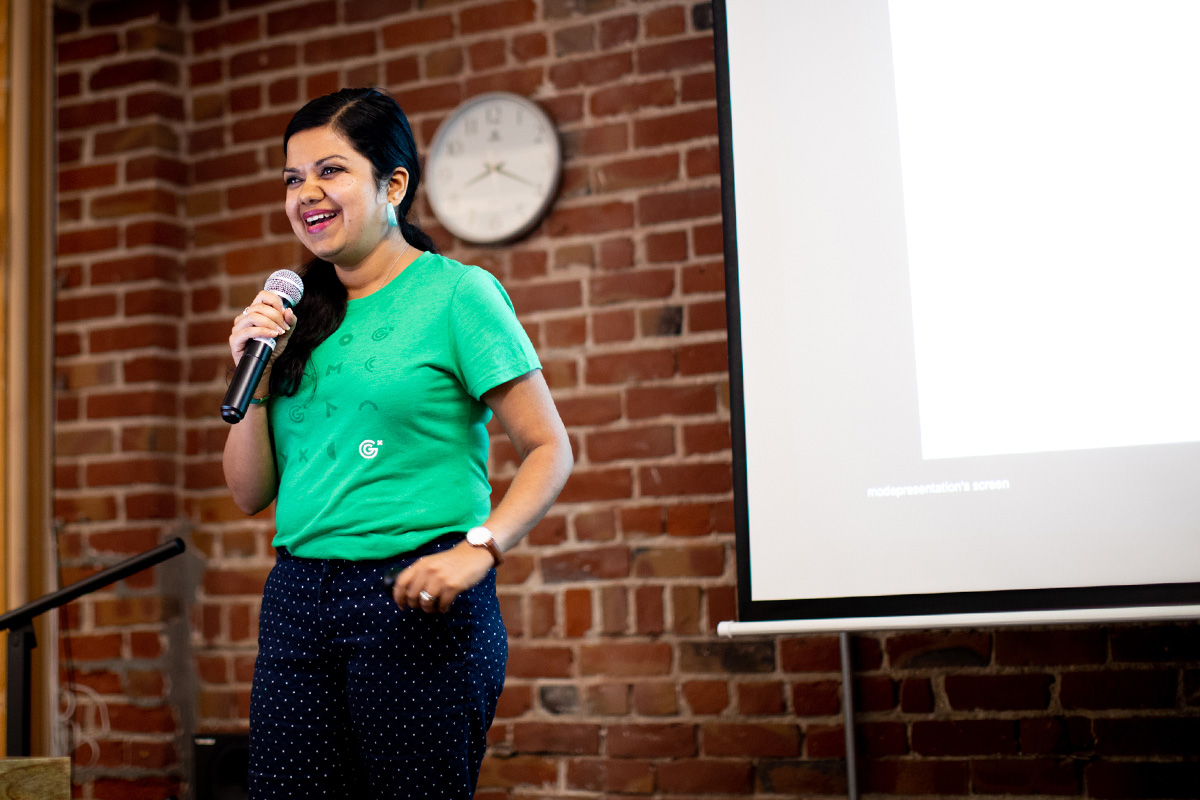
Director of Backend Application Engineering Ushashi Chakraborty gives a talk on “Limitless Growth: Practicing Inclusion in Performance Reviews” at Mode Girl Geek Dinner. Erica Kawamoto Hsu / Girl Geek X
Ushashi Chakraborty: Thank you. Hello everyone, Ushashi. I’m going to be talking about limitless growth, who doesn’t want that? Practicing inclusion in performance reviews.
Ushashi Chakraborty: So for those of you who are people managers, hopefully this talk is going to help you practice performing reviews in such a way that they are inclusive and they incentivize engineers with different kinds of stress. For those of you that are not people managers, hopefully this talk sparks an idea that helps you to ask for things from your manager when you’re sitting across them, and being deliberate in performance review.
Ushashi Chakraborty: This talk is going to have three takeaways. Let’s begin with the first one. That’s not a takeaway, that’s me. That’s the takeaway. Every engineer is different. Think about that for a second. Think about yourself, then think about your peers, various engineers that you have worked with. Seniors, juniors. Think about their strengths. Think about their ways of working. You’ll find that every engineer is different from each other even if they have largely to similar strength areas, for example, both of them are good at JavaScript. Even there, you will find nuanced differences.
Ushashi Chakraborty: Very recently, I was at the Grace Hopper conference, and there was a lot of chatter about bringing more underrepresented folks into computer science. It is great that we are at a place where we are encouraging everyone, everyone that is interested to come to this industry. Yet, don’t you think it’s absurd that we still think that people that are good at math and science, or people that are coming from traditional computer science backgrounds are the only ones that can make it well in this industry?
Ushashi Chakraborty: That is a flawed ideology. And if you take that flawed ideology, you are going to have biases. And if you start building a performance framework, you’re going to end up having a flawed performance framework.
Ushashi Chakraborty: Takeaway two. Don’t look at only one type of data. Data is great, but if you look at only one type of data, you will end up incentivizing engineers with one kind of strength. And if you incentivize engineers with one kind of strength, ultimately you will be left with an org where the engineers can solve only one kind of problem. And we don’t want that.
Ushashi Chakraborty: Most reviews that I have been part of have focused heavily on delivery. Things like code reviews, the number of code reviews that you have given. Number of comments, code quality are often given a lot of emphasis. I understand, because there’s a very easy metric to attach to these skills. And they are important skills to have. But sometimes, a different value that you add to an org, for example mentoring and interim. Or perhaps, sitting with your coworker and helping them debug a problem. Or perhaps writing a blog post for your eng blog.
Ushashi Chakraborty: We have to find ways to incentivize those skills, because all of these skills are important to excel as a software engineer. As an engineer myself, I have had reviews where those four skills are put together in one group, one bucket. And these skills are different from each other. And hence, those skills need to be talked about.
Ushashi Chakraborty: Takeaway number three. While a review conversation walks you through how your past performance has been, it is incomplete without a conversation about your future growth. How many of you here have gotten a performance review that scored you as does not meet, or meets, or exceeds? You’re familiar with that framework, right?
Ushashi Chakraborty: Now, something that has happened to me in the past is that I would get a great review that has been, a couple of times, in the past where I have gotten an exceeds. And I would be sitting there across from the manager waiting for the promotion to happen, very excited. Only there would be no promotion, there would be no talk about it at all. And I would be too uncomfortable at that point to ask for it, or ask why I didn’t get it.
Ushashi Chakraborty: When I look back at my career today, I can understand why I did not get it. Even though I was doing very well for my role at that time, I still had gaps for the next level. And hence, while the meets, not meets, exceeds framework is great, and its giving you context about how you are doing, that context is not complete unless you know how far you are from the next step. And hence, managers need to have that conversation when they’re giving you your performance reviews.
Ushashi Chakraborty: So now that we have learned about those three takeaways, let’s talk about how we do engineering performance reviews at Mode. We have adapted heavily from a framework built by Medium called Snowflake. It’s open source, you can check it out. And we rely a lot on robust conversations from managers to employees about their performance, as well as future growth. And we also take into account the inclusivity, such that engineers with different kinds of scripts are able to thrive.
Ushashi Chakraborty: The framework has four main tracks: build, execute, support, and strengthen. We will look at our favorite engineer’s performance review last quarter. Yeah, we are not embarrassed to say we have a favorite engineer. That’s our favorite engineer, Marshawn.
Ushashi Chakraborty: So let’s look at Marshawn’s performance review. So right now, Marshawn has not yet gotten a review, I’m going to review Marshawn very soon. First, let me explain the framework. So, on the right hand side you see a flake. We will start coloring that flake up as Marshawn gets some points. On the bottom, don’t worry if you can’t see, or if you can’t read what they say. The colors depict the different tracks I talked about. The building track, the executing track, the strengthening track, and the supporting track. We’re not going to get into the details of those tracks, but each track has about three to four skills.
Ushashi Chakraborty: Building is all about your code. Executing is everything that you do to get that code to production, for example in project management, communication. Supporting is the skills that you need to be supportive of your team, for example, their well-being. And strengthening is about building community inside and outside, for example, evangelism, recruit, those kind of things.
Ushashi Chakraborty: So each of these skills go from zero to five, and your manager evaluates you on those. At present, Marshawn is at zero and is an Engineer I, and total points zero. We’ll be walking you through two different scenarios of two different personas of Marshawn, and see how Marshawn plays out in these.
Ushashi Chakraborty: In the first persona, Marshawn is now having some depth of skills, or some really good skills around building and executing. You see those colors pop up, those are like getting two and three numbers in those skills. You see now, Marshawn’s title has changed to Engineer II, and Marshawn has 18 total points. So here, Marshawn is getting incentivized because of their deeper skills in building and executing, and they have shown depth in a portion of the flake.
Ushashi Chakraborty: Let’s talk about a different persona. Marshawn as a different engineer. This flake looks different. In this flake, Marshawn has a different kind of skill set. Once again, Marshawn is now in Engineer II with 18 points, but is a more holistic skillset that encompasses larger breadth of the flake. So perhaps lesser on the executing and building side, but still there, decent amount of skills. But they’re also having skills on the supporting and strengthening side of things.
Ushashi Chakraborty: Now let’s go back to those takeaways that I talked about. First, every engineer is different. So we see those personas. Those are real life engineers that we perhaps work with, having those skills. And now we are learning how to incentivize all kinds of skills while also having a way of our framework where we can provide feedback for the other kind of skills that they need to grow or hone.
Ushashi Chakraborty: The next thing, don’t look at only one type of data. Had we only focused on [inaudible] focusing on the blue and green that is the building and executing skills, and then Marshawn in persona two wouldn’t have been as successful.
Ushashi Chakraborty: Takeaway three. The framework should force the conversation about future growth. So in this little block here, the points to the next level which is 18, we see that Marshawn has 18 more points to get to the next level. So while your manager will be having a conversation with you as to how many points you are at today and how did that add up, they’ll also be having a conversation with you about how far you are from the next level and what you need to do to get there. And build this strategy with you to help you progressively get to there.
Ushashi Chakraborty: In conclusion, [inaudible] whichever side you’re sitting on during the performance review conversation, it is a challenging space to be in. I get it. And handling it with inclusivity is going to help you build an org that has all kinds of engineers that can thrive there and have professional growth that is wide, that is limitless. Thank you so much.
Heather Rivers: That was our last amazing lightning talk for the evening, but the party’s not over. Feel free to hang out here until 9:00. If you’re interested in talking to anybody about Mode, we have these green shirts, or if you’re interested in learning more about our product we have a little demo booth over there, very cool. And finally, we’re hiring in all departments, so feel free to ask any of us about our open roles. And yeah, let’s just hear one last huge round of applause for all the amazing speakers.
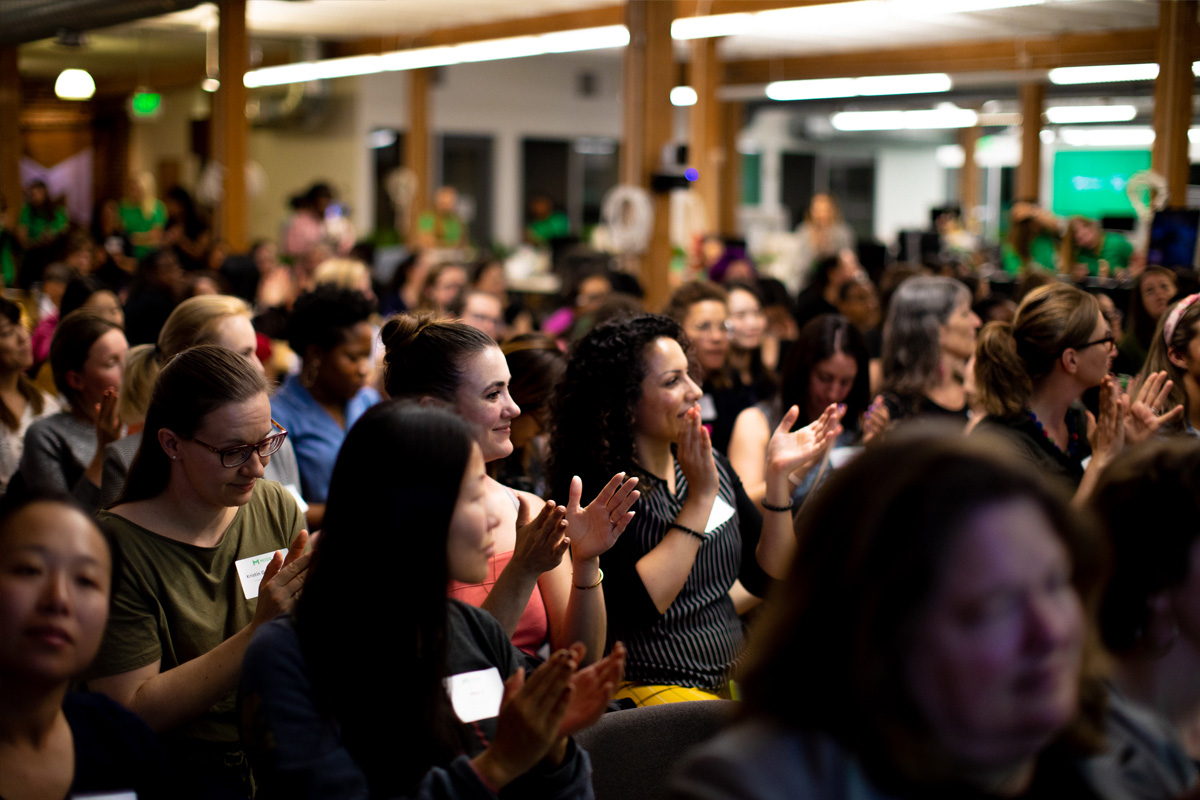
A warm round of applause for all of the speakers at Mode Girl Geek Dinner. Erica Kawamoto Hsu / Girl Geek X
Our mission-aligned Girl Geek X partners are hiring!












